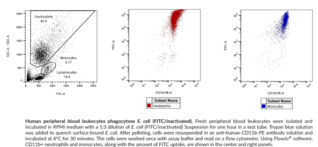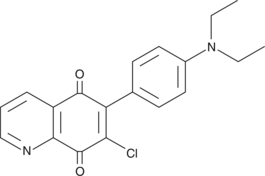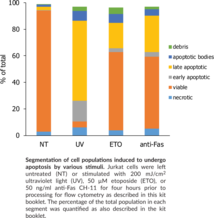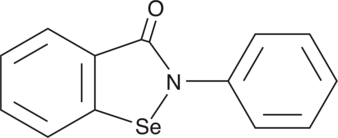Cayman
Showing 19201–19350 of 45550 results
-
Dynasore is a cell-permeable, reversible inhibitor of dynamin 1, dynamin 2, and mitochondrial dynamin, Drp1 GTPase activity (IC50 = 15 μM).{22175}{22174} Through this action, dynasore inhibits clathrin-dependent vesicle formation and endocytosis, which is necessary for internalization of certain parasites and viruses, as well as particles and receptor ligands.{22171}{22170}{22172} In some cases, dynasore can also augment the release of neurotransmitters and secreted cytokines.{22173}{22176}
Brand:CaymanSKU:- -
Dynasore is a cell-permeable, reversible inhibitor of dynamin 1, dynamin 2, and mitochondrial dynamin, Drp1 GTPase activity (IC50 = 15 μM).{22175}{22174} Through this action, dynasore inhibits clathrin-dependent vesicle formation and endocytosis, which is necessary for internalization of certain parasites and viruses, as well as particles and receptor ligands.{22171}{22170}{22172} In some cases, dynasore can also augment the release of neurotransmitters and secreted cytokines.{22173}{22176}
Brand:CaymanSKU:- -
Dyngo-4a is an inhibitor of dynamin with IC50 values of 380 and 2,300 nM for native sheep brain dynamin 1 and recombinant rat dynamin 2, respectively.{46647} It inhibits dynamin 1 helix formation induced by L-phosphatidylserine (PS) liposomes (IC50 = 0.38 µM) more potently than dynamin 1 single-ring formation induced by Grb2 (IC50 = 39.2 µM) and does not inhibit the basal GTPase activity of dynamin.{46647,46648} Dyngo-4a inhibits non-neuronal clathrin-mediated (IC50 = 5.7 µM in U2OS cells) and synaptic vesicle endocytosis (IC50 = 26.8 µM in rat brain synaptosomes).{46647}
Brand:CaymanSKU:29479 - 10 mgAvailable on backorder
-
Dyngo-4a is an inhibitor of dynamin with IC50 values of 380 and 2,300 nM for native sheep brain dynamin 1 and recombinant rat dynamin 2, respectively.{46647} It inhibits dynamin 1 helix formation induced by L-phosphatidylserine (PS) liposomes (IC50 = 0.38 µM) more potently than dynamin 1 single-ring formation induced by Grb2 (IC50 = 39.2 µM) and does not inhibit the basal GTPase activity of dynamin.{46647,46648} Dyngo-4a inhibits non-neuronal clathrin-mediated (IC50 = 5.7 µM in U2OS cells) and synaptic vesicle endocytosis (IC50 = 26.8 µM in rat brain synaptosomes).{46647}
Brand:CaymanSKU:29479 - 100 mgAvailable on backorder
-
Dyngo-4a is an inhibitor of dynamin with IC50 values of 380 and 2,300 nM for native sheep brain dynamin 1 and recombinant rat dynamin 2, respectively.{46647} It inhibits dynamin 1 helix formation induced by L-phosphatidylserine (PS) liposomes (IC50 = 0.38 µM) more potently than dynamin 1 single-ring formation induced by Grb2 (IC50 = 39.2 µM) and does not inhibit the basal GTPase activity of dynamin.{46647,46648} Dyngo-4a inhibits non-neuronal clathrin-mediated (IC50 = 5.7 µM in U2OS cells) and synaptic vesicle endocytosis (IC50 = 26.8 µM in rat brain synaptosomes).{46647}
Brand:CaymanSKU:29479 - 5 mgAvailable on backorder
-
Dyngo-4a is an inhibitor of dynamin with IC50 values of 380 and 2,300 nM for native sheep brain dynamin 1 and recombinant rat dynamin 2, respectively.{46647} It inhibits dynamin 1 helix formation induced by L-phosphatidylserine (PS) liposomes (IC50 = 0.38 µM) more potently than dynamin 1 single-ring formation induced by Grb2 (IC50 = 39.2 µM) and does not inhibit the basal GTPase activity of dynamin.{46647,46648} Dyngo-4a inhibits non-neuronal clathrin-mediated (IC50 = 5.7 µM in U2OS cells) and synaptic vesicle endocytosis (IC50 = 26.8 µM in rat brain synaptosomes).{46647}
Brand:CaymanSKU:29479 - 50 mgAvailable on backorder
-
Dynorphin A is a heptadecapeptide released from the cleavage of prodynorphin and found widely distributed in the central nervous system, where it is implicated in antinociceptive functions.{29497,29499,29498} It acts as an opioid receptor agonist with nanomolar binding affinity to the three major isotypes κ, µ, and δ (Kis = 0.5-1 nM) and has also been shown to activate human ORL1, a novel opioid receptor-like receptor (Ki = 386 nM).{29543}
Brand:CaymanSKU:-Available on backorder
-
Dynorphin A is a heptadecapeptide released from the cleavage of prodynorphin and found widely distributed in the central nervous system, where it is implicated in antinociceptive functions.{29497,29499,29498} It acts as an opioid receptor agonist with nanomolar binding affinity to the three major isotypes κ, µ, and δ (Kis = 0.5-1 nM) and has also been shown to activate human ORL1, a novel opioid receptor-like receptor (Ki = 386 nM).{29543}
Brand:CaymanSKU:-Available on backorder
-
Dynorphin A is a heptadecapeptide released from the cleavage of prodynorphin and found widely distributed in the central nervous system, where it is implicated in antinociceptive functions.{29497,29499,29498} It acts as an opioid receptor agonist with nanomolar binding affinity to the three major isotypes κ, µ, and δ (Kis = 0.5-1 nM) and has also been shown to activate human ORL1, a novel opioid receptor-like receptor (Ki = 386 nM).{29543}
Brand:CaymanSKU:-Available on backorder
-
Dynorphin A is a heptadecapeptide released from the cleavage of prodynorphin and found widely distributed in the central nervous system, where it is implicated in antinociceptive functions.{29497,29499,29498} It acts as an opioid receptor agonist with nanomolar binding affinity to the three major isotypes κ, µ, and δ (Kis = 0.5-1 nM) and has also been shown to activate human ORL1, a novel opioid receptor-like receptor (Ki = 386 nM).{29543}
Brand:CaymanSKU:-Available on backorder
-
Dynorphin B is a 13-residue opioid peptide released from the cleavage of prodynorphin and found widely distributed in the central nervous system.{29497,29499} It acts as a κ1b-opioid receptor agonist (Ki = 1.1 nM) and has been implicated in antinociceptive functions.{29498} Dynorphin B has also been used to prime cardiogenesis in pluripotent embryonic stem cells.{29500}
Brand:CaymanSKU:-Available on backorder
-
Dynorphin B is a 13-residue opioid peptide released from the cleavage of prodynorphin and found widely distributed in the central nervous system.{29497,29499} It acts as a κ1b-opioid receptor agonist (Ki = 1.1 nM) and has been implicated in antinociceptive functions.{29498} Dynorphin B has also been used to prime cardiogenesis in pluripotent embryonic stem cells.{29500}
Brand:CaymanSKU:-Available on backorder
-
Dynorphin B is a 13-residue opioid peptide released from the cleavage of prodynorphin and found widely distributed in the central nervous system.{29497,29499} It acts as a κ1b-opioid receptor agonist (Ki = 1.1 nM) and has been implicated in antinociceptive functions.{29498} Dynorphin B has also been used to prime cardiogenesis in pluripotent embryonic stem cells.{29500}
Brand:CaymanSKU:-Available on backorder
-
Dynorphin B is a 13-residue opioid peptide released from the cleavage of prodynorphin and found widely distributed in the central nervous system.{29497,29499} It acts as a κ1b-opioid receptor agonist (Ki = 1.1 nM) and has been implicated in antinociceptive functions.{29498} Dynorphin B has also been used to prime cardiogenesis in pluripotent embryonic stem cells.{29500}
Brand:CaymanSKU:-Available on backorder
-
Dyphylline is a xanthine derivative that acts as an A1 and A2 adenosine receptor antagonist and phosphodiesterase inhibitor and exhibits bronchodilator and vasodilator effects.{29139,29142} It also moderately inhibits microsomal prostaglandin E synthase-1 with an IC50 value of 200 µM and downregulates ABCG2 drug transporter expression in multidrug resistant tumor cells.{29140,29141}
Brand:CaymanSKU:-Available on backorder
-
Dyphylline is a xanthine derivative that acts as an A1 and A2 adenosine receptor antagonist and phosphodiesterase inhibitor and exhibits bronchodilator and vasodilator effects.{29139,29142} It also moderately inhibits microsomal prostaglandin E synthase-1 with an IC50 value of 200 µM and downregulates ABCG2 drug transporter expression in multidrug resistant tumor cells.{29140,29141}
Brand:CaymanSKU:-Available on backorder
-
Dyphylline is a xanthine derivative that acts as an A1 and A2 adenosine receptor antagonist and phosphodiesterase inhibitor and exhibits bronchodilator and vasodilator effects.{29139,29142} It also moderately inhibits microsomal prostaglandin E synthase-1 with an IC50 value of 200 µM and downregulates ABCG2 drug transporter expression in multidrug resistant tumor cells.{29140,29141}
Brand:CaymanSKU:-Available on backorder
-
Dyphylline is a xanthine derivative that acts as an A1 and A2 adenosine receptor antagonist and phosphodiesterase inhibitor and exhibits bronchodilator and vasodilator effects.{29139,29142} It also moderately inhibits microsomal prostaglandin E synthase-1 with an IC50 value of 200 µM and downregulates ABCG2 drug transporter expression in multidrug resistant tumor cells.{29140,29141}
Brand:CaymanSKU:-Available on backorder
-
Voltage-gated potassium ERG channels (Kv11.1), encoded by the ether-a-go-go related gene, mediate the inwardly rectifying potassium (K+) current that repolarizes myocardial cells, gut smooth muscle cells, and interstitial cells of Cajal.{24506} E-4031 is a methanesulfonanilide class III antiarrhythmic agent that prolongs cardiac action potential duration by blocking ERG K+ channels (IC50 = 29 nM).{24130,24505} E-4031 inhibits the ERG1, ERG2, and ERG3 isoforms with KD values of 99, 116, and 193 nM, respectively.{24503} However, at higher μM concentrations E-4031 can demonstrate pro-arrhythmic activity, inducing early after depolarizations (prolonged repolarization) in cell models and torsade de pointes in animal models.{24131} E-4031 has been used to pharmacologically rescue misprocessed ERG in long QT syndrome type 2, an autosomal dominant cardiac disease associated with prolongation of the QT interval and torsade de pointes.{24504}
Brand:CaymanSKU:- -
Voltage-gated potassium ERG channels (Kv11.1), encoded by the ether-a-go-go related gene, mediate the inwardly rectifying potassium (K+) current that repolarizes myocardial cells, gut smooth muscle cells, and interstitial cells of Cajal.{24506} E-4031 is a methanesulfonanilide class III antiarrhythmic agent that prolongs cardiac action potential duration by blocking ERG K+ channels (IC50 = 29 nM).{24130,24505} E-4031 inhibits the ERG1, ERG2, and ERG3 isoforms with KD values of 99, 116, and 193 nM, respectively.{24503} However, at higher μM concentrations E-4031 can demonstrate pro-arrhythmic activity, inducing early after depolarizations (prolonged repolarization) in cell models and torsade de pointes in animal models.{24131} E-4031 has been used to pharmacologically rescue misprocessed ERG in long QT syndrome type 2, an autosomal dominant cardiac disease associated with prolongation of the QT interval and torsade de pointes.{24504}
Brand:CaymanSKU:- -
Voltage-gated potassium ERG channels (Kv11.1), encoded by the ether-a-go-go related gene, mediate the inwardly rectifying potassium (K+) current that repolarizes myocardial cells, gut smooth muscle cells, and interstitial cells of Cajal.{24506} E-4031 is a methanesulfonanilide class III antiarrhythmic agent that prolongs cardiac action potential duration by blocking ERG K+ channels (IC50 = 29 nM).{24130,24505} E-4031 inhibits the ERG1, ERG2, and ERG3 isoforms with KD values of 99, 116, and 193 nM, respectively.{24503} However, at higher μM concentrations E-4031 can demonstrate pro-arrhythmic activity, inducing early after depolarizations (prolonged repolarization) in cell models and torsade de pointes in animal models.{24131} E-4031 has been used to pharmacologically rescue misprocessed ERG in long QT syndrome type 2, an autosomal dominant cardiac disease associated with prolongation of the QT interval and torsade de pointes.{24504}
Brand:CaymanSKU:- -
Voltage-gated potassium ERG channels (Kv11.1), encoded by the ether-a-go-go related gene, mediate the inwardly rectifying potassium (K+) current that repolarizes myocardial cells, gut smooth muscle cells, and interstitial cells of Cajal.{24506} E-4031 is a methanesulfonanilide class III antiarrhythmic agent that prolongs cardiac action potential duration by blocking ERG K+ channels (IC50 = 29 nM).{24130,24505} E-4031 inhibits the ERG1, ERG2, and ERG3 isoforms with KD values of 99, 116, and 193 nM, respectively.{24503} However, at higher μM concentrations E-4031 can demonstrate pro-arrhythmic activity, inducing early after depolarizations (prolonged repolarization) in cell models and torsade de pointes in animal models.{24131} E-4031 has been used to pharmacologically rescue misprocessed ERG in long QT syndrome type 2, an autosomal dominant cardiac disease associated with prolongation of the QT interval and torsade de pointes.{24504}
Brand:CaymanSKU:- -
E-64 is a fungal metabolite originally isolated from Aspergillus japonicus that has diverse biological activities.{52880,17474,54647,52881,52882} It inhibits a variety of cysteine proteases, including cathepsins B, H, and L, as well as papain, ficin, and bromelain, but not the serine proteases plasmin, trypsin, and tissue kallikrein or the aspartic protease pepsin.{17474,52880} E-64 (0.1-2 mg/ml) reduces the autocatalytic activity of the foot-and-mouth-disease virus (FMDV) leader protease.{54647} It is active against the FCR3 P. falciparum strain with an IC50 value of 836 nM.{52881} E-64 (5-25 µM) reduces bone resorption in embryonic mouse bone explants.{52882}
Brand:CaymanSKU:10007963 - 10 mgAvailable on backorder
-
E-64 is a fungal metabolite originally isolated from Aspergillus japonicus that has diverse biological activities.{52880,17474,54647,52881,52882} It inhibits a variety of cysteine proteases, including cathepsins B, H, and L, as well as papain, ficin, and bromelain, but not the serine proteases plasmin, trypsin, and tissue kallikrein or the aspartic protease pepsin.{17474,52880} E-64 (0.1-2 mg/ml) reduces the autocatalytic activity of the foot-and-mouth-disease virus (FMDV) leader protease.{54647} It is active against the FCR3 P. falciparum strain with an IC50 value of 836 nM.{52881} E-64 (5-25 µM) reduces bone resorption in embryonic mouse bone explants.{52882}
Brand:CaymanSKU:10007963 - 25 mgAvailable on backorder
-
E-64 is a fungal metabolite originally isolated from Aspergillus japonicus that has diverse biological activities.{52880,17474,54647,52881,52882} It inhibits a variety of cysteine proteases, including cathepsins B, H, and L, as well as papain, ficin, and bromelain, but not the serine proteases plasmin, trypsin, and tissue kallikrein or the aspartic protease pepsin.{17474,52880} E-64 (0.1-2 mg/ml) reduces the autocatalytic activity of the foot-and-mouth-disease virus (FMDV) leader protease.{54647} It is active against the FCR3 P. falciparum strain with an IC50 value of 836 nM.{52881} E-64 (5-25 µM) reduces bone resorption in embryonic mouse bone explants.{52882}
Brand:CaymanSKU:10007963 - 5 mgAvailable on backorder
-
E-64 is a fungal metabolite originally isolated from Aspergillus japonicus that has diverse biological activities.{52880,17474,54647,52881,52882} It inhibits a variety of cysteine proteases, including cathepsins B, H, and L, as well as papain, ficin, and bromelain, but not the serine proteases plasmin, trypsin, and tissue kallikrein or the aspartic protease pepsin.{17474,52880} E-64 (0.1-2 mg/ml) reduces the autocatalytic activity of the foot-and-mouth-disease virus (FMDV) leader protease.{54647} It is active against the FCR3 P. falciparum strain with an IC50 value of 836 nM.{52881} E-64 (5-25 µM) reduces bone resorption in embryonic mouse bone explants.{52882}
Brand:CaymanSKU:10007963 - 50 mgAvailable on backorder
-
E-64c is an active metabolite of the protease inhibitor E-64d (Item No. 13533).{14249,58182,54647,54648} E-64c inhibits the cysteine proteases cathepsin B, cathepsin H, and papain but not the serine proteases trypsin, chymotrypsin, or elastase.{17474,54649} It reduces the autocatalytic activity of the foot-and-mouth-disease virus (FMDV) leader protease when used at concentrations ranging from 0.1 to 1 mg/ml.{54647} E-64c reduces infection of HEK293T cells by an HIV-based virus system pseudotyped with severe acute respiratory syndrome coronavirus (SARS-CoV) surface glycoprotein, also known as the spike glycoprotein, in a concentration-dependent manner.{54648}
Brand:CaymanSKU:10007964 - 1 mgAvailable on backorder
-
E-64c is an active metabolite of the protease inhibitor E-64d (Item No. 13533).{14249,58182,54647,54648} E-64c inhibits the cysteine proteases cathepsin B, cathepsin H, and papain but not the serine proteases trypsin, chymotrypsin, or elastase.{17474,54649} It reduces the autocatalytic activity of the foot-and-mouth-disease virus (FMDV) leader protease when used at concentrations ranging from 0.1 to 1 mg/ml.{54647} E-64c reduces infection of HEK293T cells by an HIV-based virus system pseudotyped with severe acute respiratory syndrome coronavirus (SARS-CoV) surface glycoprotein, also known as the spike glycoprotein, in a concentration-dependent manner.{54648}
Brand:CaymanSKU:10007964 - 10 mgAvailable on backorder
-
E-64c is an active metabolite of the protease inhibitor E-64d (Item No. 13533).{14249,58182,54647,54648} E-64c inhibits the cysteine proteases cathepsin B, cathepsin H, and papain but not the serine proteases trypsin, chymotrypsin, or elastase.{17474,54649} It reduces the autocatalytic activity of the foot-and-mouth-disease virus (FMDV) leader protease when used at concentrations ranging from 0.1 to 1 mg/ml.{54647} E-64c reduces infection of HEK293T cells by an HIV-based virus system pseudotyped with severe acute respiratory syndrome coronavirus (SARS-CoV) surface glycoprotein, also known as the spike glycoprotein, in a concentration-dependent manner.{54648}
Brand:CaymanSKU:10007964 - 25 mgAvailable on backorder
-
E-64c is an active metabolite of the protease inhibitor E-64d (Item No. 13533).{14249,58182,54647,54648} E-64c inhibits the cysteine proteases cathepsin B, cathepsin H, and papain but not the serine proteases trypsin, chymotrypsin, or elastase.{17474,54649} It reduces the autocatalytic activity of the foot-and-mouth-disease virus (FMDV) leader protease when used at concentrations ranging from 0.1 to 1 mg/ml.{54647} E-64c reduces infection of HEK293T cells by an HIV-based virus system pseudotyped with severe acute respiratory syndrome coronavirus (SARS-CoV) surface glycoprotein, also known as the spike glycoprotein, in a concentration-dependent manner.{54648}
Brand:CaymanSKU:10007964 - 5 mgAvailable on backorder
-
E-64d is an irreversible, membrane-permeable inhibitor of lysosomal and cytosolic cysteine proteases and has diverse biological activities.{18463,14249,18464,49542} It is a synthetic analog of E-64 (Item No. 10007963) and prodrug form of E-64c (Item No. 10007964) that inhibits calpain and the cysteine proteases cathepsins F, -K, -B, -H, and -L.{18463, 58182} E-64d (20-200 µM) induces cell cycle arrest at the G2/M phase in A431 human epidermoid carcinoma cells.{14249} It inhibits protease-resistant prion protein accumulation in scrapie-infected neuroblastoma cells with an IC50 value of 0.5 µM.{18464} E-64d also inhibits severe acute respiratory syndrome coronavirus (SARS-CoV) and SARS-CoV-2 surface glycoprotein incorporation into pseudotyped vesicular stomatitis virus (VSV) particles in Vero cells, an effect that is reduced by expression of the serine protease TMPRSS2.{49542}
Brand:CaymanSKU:- -
E-64d is an irreversible, membrane-permeable inhibitor of lysosomal and cytosolic cysteine proteases and has diverse biological activities.{18463,14249,18464,49542} It is a synthetic analog of E-64 (Item No. 10007963) and prodrug form of E-64c (Item No. 10007964) that inhibits calpain and the cysteine proteases cathepsins F, -K, -B, -H, and -L.{18463, 58182} E-64d (20-200 µM) induces cell cycle arrest at the G2/M phase in A431 human epidermoid carcinoma cells.{14249} It inhibits protease-resistant prion protein accumulation in scrapie-infected neuroblastoma cells with an IC50 value of 0.5 µM.{18464} E-64d also inhibits severe acute respiratory syndrome coronavirus (SARS-CoV) and SARS-CoV-2 surface glycoprotein incorporation into pseudotyped vesicular stomatitis virus (VSV) particles in Vero cells, an effect that is reduced by expression of the serine protease TMPRSS2.{49542}
Brand:CaymanSKU:- -
E-64d is an irreversible, membrane-permeable inhibitor of lysosomal and cytosolic cysteine proteases and has diverse biological activities.{18463,14249,18464,49542} It is a synthetic analog of E-64 (Item No. 10007963) and prodrug form of E-64c (Item No. 10007964) that inhibits calpain and the cysteine proteases cathepsins F, -K, -B, -H, and -L.{18463, 58182} E-64d (20-200 µM) induces cell cycle arrest at the G2/M phase in A431 human epidermoid carcinoma cells.{14249} It inhibits protease-resistant prion protein accumulation in scrapie-infected neuroblastoma cells with an IC50 value of 0.5 µM.{18464} E-64d also inhibits severe acute respiratory syndrome coronavirus (SARS-CoV) and SARS-CoV-2 surface glycoprotein incorporation into pseudotyped vesicular stomatitis virus (VSV) particles in Vero cells, an effect that is reduced by expression of the serine protease TMPRSS2.{49542}
Brand:CaymanSKU:- -
E-64d is an irreversible, membrane-permeable inhibitor of lysosomal and cytosolic cysteine proteases and has diverse biological activities.{18463,14249,18464,49542} It is a synthetic analog of E-64 (Item No. 10007963) and prodrug form of E-64c (Item No. 10007964) that inhibits calpain and the cysteine proteases cathepsins F, -K, -B, -H, and -L.{18463, 58182} E-64d (20-200 µM) induces cell cycle arrest at the G2/M phase in A431 human epidermoid carcinoma cells.{14249} It inhibits protease-resistant prion protein accumulation in scrapie-infected neuroblastoma cells with an IC50 value of 0.5 µM.{18464} E-64d also inhibits severe acute respiratory syndrome coronavirus (SARS-CoV) and SARS-CoV-2 surface glycoprotein incorporation into pseudotyped vesicular stomatitis virus (VSV) particles in Vero cells, an effect that is reduced by expression of the serine protease TMPRSS2.{49542}
Brand:CaymanSKU:- -
Cayman’s E. coli Phagocytosis Assay Kit employs FITC-labeled, heat-inactivated E. coli cells for the measurement of the phagocytic process in vitro. The engulfed fluorescent E. coli can be detected by flow cytometry.
Brand:CaymanSKU:601370 - 100 testsAvailable on backorder
-
E2012 is a modulator of γ-secretase.{48834} It selectively inhibits APP intracellular signaling domain (AICD) cleavage to amyloid-β (Aβ) over Notch cleavage to its signaling effector Notch intracellular domain (NICD), processes both mediated by γ-secretase, when used at a concentration of 1 µM in luciferase assays.{48835} E2012 also inhibits the activity of the cholesterol synthesis enzyme 3β-hydroxysterol ∆24-reductase (DHCR24) in primary rat hepatocytes and HepG2 cells (IC50s = 11 and 15 nM, respectively).{48836} It reduces Aβ (1-42) (Aβ42) production in primary rat embryonic cerebral cortex neurons with an IC50 value of 220 nM.{48837} E2012 (100 mg/kg) also decreases Aβ42 levels in guinea pig brain and cerebral spinal fluid (CSF).{48837}
Brand:CaymanSKU:29710 - 10 mgAvailable on backorder
-
E2012 is a modulator of γ-secretase.{48834} It selectively inhibits APP intracellular signaling domain (AICD) cleavage to amyloid-β (Aβ) over Notch cleavage to its signaling effector Notch intracellular domain (NICD), processes both mediated by γ-secretase, when used at a concentration of 1 µM in luciferase assays.{48835} E2012 also inhibits the activity of the cholesterol synthesis enzyme 3β-hydroxysterol ∆24-reductase (DHCR24) in primary rat hepatocytes and HepG2 cells (IC50s = 11 and 15 nM, respectively).{48836} It reduces Aβ (1-42) (Aβ42) production in primary rat embryonic cerebral cortex neurons with an IC50 value of 220 nM.{48837} E2012 (100 mg/kg) also decreases Aβ42 levels in guinea pig brain and cerebral spinal fluid (CSF).{48837}
Brand:CaymanSKU:29710 - 25 mgAvailable on backorder
-
E2012 is a modulator of γ-secretase.{48834} It selectively inhibits APP intracellular signaling domain (AICD) cleavage to amyloid-β (Aβ) over Notch cleavage to its signaling effector Notch intracellular domain (NICD), processes both mediated by γ-secretase, when used at a concentration of 1 µM in luciferase assays.{48835} E2012 also inhibits the activity of the cholesterol synthesis enzyme 3β-hydroxysterol ∆24-reductase (DHCR24) in primary rat hepatocytes and HepG2 cells (IC50s = 11 and 15 nM, respectively).{48836} It reduces Aβ (1-42) (Aβ42) production in primary rat embryonic cerebral cortex neurons with an IC50 value of 220 nM.{48837} E2012 (100 mg/kg) also decreases Aβ42 levels in guinea pig brain and cerebral spinal fluid (CSF).{48837}
Brand:CaymanSKU:29710 - 5 mgAvailable on backorder
-
E2012 is a modulator of γ-secretase.{48834} It selectively inhibits APP intracellular signaling domain (AICD) cleavage to amyloid-β (Aβ) over Notch cleavage to its signaling effector Notch intracellular domain (NICD), processes both mediated by γ-secretase, when used at a concentration of 1 µM in luciferase assays.{48835} E2012 also inhibits the activity of the cholesterol synthesis enzyme 3β-hydroxysterol ∆24-reductase (DHCR24) in primary rat hepatocytes and HepG2 cells (IC50s = 11 and 15 nM, respectively).{48836} It reduces Aβ (1-42) (Aβ42) production in primary rat embryonic cerebral cortex neurons with an IC50 value of 220 nM.{48837} E2012 (100 mg/kg) also decreases Aβ42 levels in guinea pig brain and cerebral spinal fluid (CSF).{48837}
Brand:CaymanSKU:29710 - 50 mgAvailable on backorder
-
E3330 is an inhibitor of apurinic-apyrimidinic endonuclease 1/redox factor-1 (APE1/Ref-1) redox activity.{59711,59712} It inhibits APE1-mediated AP-1 DNA binding activity with an IC50 value of 6.5 µM in a redox EMSA but has no effect on APE1-mediated DNA repair activity in endonuclease or gap-filling assays when used at concentrations ranging from 0.01 to 50 µM.{59711} E3330 reduces basal activation of NF-κB, AP-1, and HIF-1 in reporter assays using PANC-1 pancreatic cancer cells.{59712} It inhibits proliferation of PaCa-2 and PANC-1 pancreatic cancer cells (EC50s = 135 and 87 µM, respectively). E3330 (25 mg/kg) inhibits tumor growth in a PaCa-2 mouse xenograft model and pancreatic cancer patient-derived xenograft (PDX) mouse models.
Brand:CaymanSKU:32830 - 10 mgAvailable on backorder
-
E3330 is an inhibitor of apurinic-apyrimidinic endonuclease 1/redox factor-1 (APE1/Ref-1) redox activity.{59711,59712} It inhibits APE1-mediated AP-1 DNA binding activity with an IC50 value of 6.5 µM in a redox EMSA but has no effect on APE1-mediated DNA repair activity in endonuclease or gap-filling assays when used at concentrations ranging from 0.01 to 50 µM.{59711} E3330 reduces basal activation of NF-κB, AP-1, and HIF-1 in reporter assays using PANC-1 pancreatic cancer cells.{59712} It inhibits proliferation of PaCa-2 and PANC-1 pancreatic cancer cells (EC50s = 135 and 87 µM, respectively). E3330 (25 mg/kg) inhibits tumor growth in a PaCa-2 mouse xenograft model and pancreatic cancer patient-derived xenograft (PDX) mouse models.
Brand:CaymanSKU:32830 - 25 mgAvailable on backorder
-
E3330 is an inhibitor of apurinic-apyrimidinic endonuclease 1/redox factor-1 (APE1/Ref-1) redox activity.{59711,59712} It inhibits APE1-mediated AP-1 DNA binding activity with an IC50 value of 6.5 µM in a redox EMSA but has no effect on APE1-mediated DNA repair activity in endonuclease or gap-filling assays when used at concentrations ranging from 0.01 to 50 µM.{59711} E3330 reduces basal activation of NF-κB, AP-1, and HIF-1 in reporter assays using PANC-1 pancreatic cancer cells.{59712} It inhibits proliferation of PaCa-2 and PANC-1 pancreatic cancer cells (EC50s = 135 and 87 µM, respectively). E3330 (25 mg/kg) inhibits tumor growth in a PaCa-2 mouse xenograft model and pancreatic cancer patient-derived xenograft (PDX) mouse models.
Brand:CaymanSKU:32830 - 5 mgAvailable on backorder
-
E6005 is an inhibitor of phosphodiesterase 4 (PDE4; IC50 = 2.8 nM).{53585} It is selective for PDE4 over PDE1, PDE2, PDE3, and PDE5 with only 46.1, 51.6, 69.4, and 57.4% inhibition, respectively, at 30 µM. It inhibits the production of various cytokines in isolated human lymphocytes and monocytes (IC50s = 0.49-3.1 nM). Topical application of E6005 (0.003-0.3%) reduces ear thickness in a mouse model of oxazolone-induced skin inflammation, as well as reduces oxazolone-induced scratching in mice. It reduces the severity of skin lesions in a model of mite-induced atopic dermatitis. Topical application of E6005 (0.03%) also inhibits the production of leukotriene B4 (LTB4; Item No. 20110) in mouse skin, as well as reduces scratching and cutaneous nerve firing induced by the proteinase-activated receptor 2 (PAR2) agonist SLIGRL-NH2 (Item No. 16723) in mice.{53586}
Brand:CaymanSKU:30203 - 1 mgAvailable on backorder
-
E6005 is an inhibitor of phosphodiesterase 4 (PDE4; IC50 = 2.8 nM).{53585} It is selective for PDE4 over PDE1, PDE2, PDE3, and PDE5 with only 46.1, 51.6, 69.4, and 57.4% inhibition, respectively, at 30 µM. It inhibits the production of various cytokines in isolated human lymphocytes and monocytes (IC50s = 0.49-3.1 nM). Topical application of E6005 (0.003-0.3%) reduces ear thickness in a mouse model of oxazolone-induced skin inflammation, as well as reduces oxazolone-induced scratching in mice. It reduces the severity of skin lesions in a model of mite-induced atopic dermatitis. Topical application of E6005 (0.03%) also inhibits the production of leukotriene B4 (LTB4; Item No. 20110) in mouse skin, as well as reduces scratching and cutaneous nerve firing induced by the proteinase-activated receptor 2 (PAR2) agonist SLIGRL-NH2 (Item No. 16723) in mice.{53586}
Brand:CaymanSKU:30203 - 10 mgAvailable on backorder
-
E6005 is an inhibitor of phosphodiesterase 4 (PDE4; IC50 = 2.8 nM).{53585} It is selective for PDE4 over PDE1, PDE2, PDE3, and PDE5 with only 46.1, 51.6, 69.4, and 57.4% inhibition, respectively, at 30 µM. It inhibits the production of various cytokines in isolated human lymphocytes and monocytes (IC50s = 0.49-3.1 nM). Topical application of E6005 (0.003-0.3%) reduces ear thickness in a mouse model of oxazolone-induced skin inflammation, as well as reduces oxazolone-induced scratching in mice. It reduces the severity of skin lesions in a model of mite-induced atopic dermatitis. Topical application of E6005 (0.03%) also inhibits the production of leukotriene B4 (LTB4; Item No. 20110) in mouse skin, as well as reduces scratching and cutaneous nerve firing induced by the proteinase-activated receptor 2 (PAR2) agonist SLIGRL-NH2 (Item No. 16723) in mice.{53586}
Brand:CaymanSKU:30203 - 25 mgAvailable on backorder
-
E6005 is an inhibitor of phosphodiesterase 4 (PDE4; IC50 = 2.8 nM).{53585} It is selective for PDE4 over PDE1, PDE2, PDE3, and PDE5 with only 46.1, 51.6, 69.4, and 57.4% inhibition, respectively, at 30 µM. It inhibits the production of various cytokines in isolated human lymphocytes and monocytes (IC50s = 0.49-3.1 nM). Topical application of E6005 (0.003-0.3%) reduces ear thickness in a mouse model of oxazolone-induced skin inflammation, as well as reduces oxazolone-induced scratching in mice. It reduces the severity of skin lesions in a model of mite-induced atopic dermatitis. Topical application of E6005 (0.03%) also inhibits the production of leukotriene B4 (LTB4; Item No. 20110) in mouse skin, as well as reduces scratching and cutaneous nerve firing induced by the proteinase-activated receptor 2 (PAR2) agonist SLIGRL-NH2 (Item No. 16723) in mice.{53586}
Brand:CaymanSKU:30203 - 5 mgAvailable on backorder
-
E7046 is a specific antagonist of the type 4 prostaglandin E2 (PGE2) receptor EP4. It possesses significant antitumor growth activity in multiple preclinical tumor models through modulating myeloid cells, including tumor-associated macrophages and myeloid-derived suppressor cells.{31905} E7046 is being evaluated in cancer models and clinical trials, alone or in combination with other immunotherapeutic compounds.{31904,31906}
Brand:CaymanSKU:19673 -Available on backorder
-
E7046 is a specific antagonist of the type 4 prostaglandin E2 (PGE2) receptor EP4. It possesses significant antitumor growth activity in multiple preclinical tumor models through modulating myeloid cells, including tumor-associated macrophages and myeloid-derived suppressor cells.{31905} E7046 is being evaluated in cancer models and clinical trials, alone or in combination with other immunotherapeutic compounds.{31904,31906}
Brand:CaymanSKU:19673 -Available on backorder
-
E7046 is a specific antagonist of the type 4 prostaglandin E2 (PGE2) receptor EP4. It possesses significant antitumor growth activity in multiple preclinical tumor models through modulating myeloid cells, including tumor-associated macrophages and myeloid-derived suppressor cells.{31905} E7046 is being evaluated in cancer models and clinical trials, alone or in combination with other immunotherapeutic compounds.{31904,31906}
Brand:CaymanSKU:19673 -Available on backorder
-
E7046 is a specific antagonist of the type 4 prostaglandin E2 (PGE2) receptor EP4. It possesses significant antitumor growth activity in multiple preclinical tumor models through modulating myeloid cells, including tumor-associated macrophages and myeloid-derived suppressor cells.{31905} E7046 is being evaluated in cancer models and clinical trials, alone or in combination with other immunotherapeutic compounds.{31904,31906}
Brand:CaymanSKU:19673 -Available on backorder
-
E7449 is an inhibitor of poly(ADP-ribose) polymerase 1 (PARP1) and PARP2 (IC50s = 1 and 1.2 nM, respectively) as well as tankyrase (TNKS) 1/2 (IC50s = 50-100 nM).{42154} It is selective for PARP1, PARP2, and TNKS1/2 over PARP3 and PARP6-15 (IC50s = >3 μM). E7449 binds to chromatin in a concentration-dependent manner and inhibits growth of DT40 cells in a PARP-dependent manner (IC50s = 3.2 and >15 μM for wild-type and PARP-/- cells, respectively). It also decreases expression of the Wnt/β-catenin signaling pathway proteins axin2, total and active β-catenin, and cyclin D1 in SW480 cells. In vivo, E7449 enhances tumor growth inhibition induced by temozolomide (TMZ; Item No. 14163) in a B16/F10 isograft model as well as antitumor activity of the DNA-crosslinking agent carboplatin (Item No. 13112) in an MX-1 mouse xenograft model. E7449 (30 and 100 mg/kg per day) inhibits tumor growth in a BRCA1 mutant MDA-MB-436 breast cancer mouse xenograft model and induces complete inhibition of tumor cell PARP activity in an NCI-H460 lung cancer mouse xenograft model when administered at a dose of 100 mg/kg. It also delays hair regrowth, a TNKS-dependent process, in mice following hair removal.
Brand:CaymanSKU:21658 -Out of stock
-
E7449 is an inhibitor of poly(ADP-ribose) polymerase 1 (PARP1) and PARP2 (IC50s = 1 and 1.2 nM, respectively) as well as tankyrase (TNKS) 1/2 (IC50s = 50-100 nM).{42154} It is selective for PARP1, PARP2, and TNKS1/2 over PARP3 and PARP6-15 (IC50s = >3 μM). E7449 binds to chromatin in a concentration-dependent manner and inhibits growth of DT40 cells in a PARP-dependent manner (IC50s = 3.2 and >15 μM for wild-type and PARP-/- cells, respectively). It also decreases expression of the Wnt/β-catenin signaling pathway proteins axin2, total and active β-catenin, and cyclin D1 in SW480 cells. In vivo, E7449 enhances tumor growth inhibition induced by temozolomide (TMZ; Item No. 14163) in a B16/F10 isograft model as well as antitumor activity of the DNA-crosslinking agent carboplatin (Item No. 13112) in an MX-1 mouse xenograft model. E7449 (30 and 100 mg/kg per day) inhibits tumor growth in a BRCA1 mutant MDA-MB-436 breast cancer mouse xenograft model and induces complete inhibition of tumor cell PARP activity in an NCI-H460 lung cancer mouse xenograft model when administered at a dose of 100 mg/kg. It also delays hair regrowth, a TNKS-dependent process, in mice following hair removal.
Brand:CaymanSKU:21658 -Out of stock
-
E7449 is an inhibitor of poly(ADP-ribose) polymerase 1 (PARP1) and PARP2 (IC50s = 1 and 1.2 nM, respectively) as well as tankyrase (TNKS) 1/2 (IC50s = 50-100 nM).{42154} It is selective for PARP1, PARP2, and TNKS1/2 over PARP3 and PARP6-15 (IC50s = >3 μM). E7449 binds to chromatin in a concentration-dependent manner and inhibits growth of DT40 cells in a PARP-dependent manner (IC50s = 3.2 and >15 μM for wild-type and PARP-/- cells, respectively). It also decreases expression of the Wnt/β-catenin signaling pathway proteins axin2, total and active β-catenin, and cyclin D1 in SW480 cells. In vivo, E7449 enhances tumor growth inhibition induced by temozolomide (TMZ; Item No. 14163) in a B16/F10 isograft model as well as antitumor activity of the DNA-crosslinking agent carboplatin (Item No. 13112) in an MX-1 mouse xenograft model. E7449 (30 and 100 mg/kg per day) inhibits tumor growth in a BRCA1 mutant MDA-MB-436 breast cancer mouse xenograft model and induces complete inhibition of tumor cell PARP activity in an NCI-H460 lung cancer mouse xenograft model when administered at a dose of 100 mg/kg. It also delays hair regrowth, a TNKS-dependent process, in mice following hair removal.
Brand:CaymanSKU:21658 -Out of stock
-
E7449 is an inhibitor of poly(ADP-ribose) polymerase 1 (PARP1) and PARP2 (IC50s = 1 and 1.2 nM, respectively) as well as tankyrase (TNKS) 1/2 (IC50s = 50-100 nM).{42154} It is selective for PARP1, PARP2, and TNKS1/2 over PARP3 and PARP6-15 (IC50s = >3 μM). E7449 binds to chromatin in a concentration-dependent manner and inhibits growth of DT40 cells in a PARP-dependent manner (IC50s = 3.2 and >15 μM for wild-type and PARP-/- cells, respectively). It also decreases expression of the Wnt/β-catenin signaling pathway proteins axin2, total and active β-catenin, and cyclin D1 in SW480 cells. In vivo, E7449 enhances tumor growth inhibition induced by temozolomide (TMZ; Item No. 14163) in a B16/F10 isograft model as well as antitumor activity of the DNA-crosslinking agent carboplatin (Item No. 13112) in an MX-1 mouse xenograft model. E7449 (30 and 100 mg/kg per day) inhibits tumor growth in a BRCA1 mutant MDA-MB-436 breast cancer mouse xenograft model and induces complete inhibition of tumor cell PARP activity in an NCI-H460 lung cancer mouse xenograft model when administered at a dose of 100 mg/kg. It also delays hair regrowth, a TNKS-dependent process, in mice following hair removal.
Brand:CaymanSKU:21658 -Out of stock
-
E7820 is a sulfonamide derivative and an angiogenesis inhibitor that inhibits bFGF- and VEGF-stimulated human umbilical vein endothelial cell (HUVEC) proliferation (IC50s = 0.1 and 0.081 μg/ml, respectively).{39954} It inhibits bFGF- and VEGF-stimulated tube formation of HUVECs in a concentration-dependent manner (IC50s = 0.2 and 0.24 μg/ml, respectively). E7820 selectively decreases the surface expression and mRNA levels of integrin α2 over CD31 and VE-cadherin in HUVECs. In vivo, E7820 (200 and 400 mg/kg) reduces tumor growth and inhibits angiogenesis in a WiDr colorectal cancer mouse xenograft model. It also reduces tumor weight in a panel of seven human colon, breast, pancreas, and kidney cancer mouse xenograft models, completely inhibits tumor growth in KP-1 pancreatic and LoVo colon cancer mouse xenograft models, and inhibits tumor growth in KP-1 and COLO 320DM mouse orthotopic transplantation models.{39955}
Brand:CaymanSKU:25502 - 10 mgAvailable on backorder
-
E7820 is a sulfonamide derivative and an angiogenesis inhibitor that inhibits bFGF- and VEGF-stimulated human umbilical vein endothelial cell (HUVEC) proliferation (IC50s = 0.1 and 0.081 μg/ml, respectively).{39954} It inhibits bFGF- and VEGF-stimulated tube formation of HUVECs in a concentration-dependent manner (IC50s = 0.2 and 0.24 μg/ml, respectively). E7820 selectively decreases the surface expression and mRNA levels of integrin α2 over CD31 and VE-cadherin in HUVECs. In vivo, E7820 (200 and 400 mg/kg) reduces tumor growth and inhibits angiogenesis in a WiDr colorectal cancer mouse xenograft model. It also reduces tumor weight in a panel of seven human colon, breast, pancreas, and kidney cancer mouse xenograft models, completely inhibits tumor growth in KP-1 pancreatic and LoVo colon cancer mouse xenograft models, and inhibits tumor growth in KP-1 and COLO 320DM mouse orthotopic transplantation models.{39955}
Brand:CaymanSKU:25502 - 100 mgAvailable on backorder
-
E7820 is a sulfonamide derivative and an angiogenesis inhibitor that inhibits bFGF- and VEGF-stimulated human umbilical vein endothelial cell (HUVEC) proliferation (IC50s = 0.1 and 0.081 μg/ml, respectively).{39954} It inhibits bFGF- and VEGF-stimulated tube formation of HUVECs in a concentration-dependent manner (IC50s = 0.2 and 0.24 μg/ml, respectively). E7820 selectively decreases the surface expression and mRNA levels of integrin α2 over CD31 and VE-cadherin in HUVECs. In vivo, E7820 (200 and 400 mg/kg) reduces tumor growth and inhibits angiogenesis in a WiDr colorectal cancer mouse xenograft model. It also reduces tumor weight in a panel of seven human colon, breast, pancreas, and kidney cancer mouse xenograft models, completely inhibits tumor growth in KP-1 pancreatic and LoVo colon cancer mouse xenograft models, and inhibits tumor growth in KP-1 and COLO 320DM mouse orthotopic transplantation models.{39955}
Brand:CaymanSKU:25502 - 5 mgAvailable on backorder
-
E7820 is a sulfonamide derivative and an angiogenesis inhibitor that inhibits bFGF- and VEGF-stimulated human umbilical vein endothelial cell (HUVEC) proliferation (IC50s = 0.1 and 0.081 μg/ml, respectively).{39954} It inhibits bFGF- and VEGF-stimulated tube formation of HUVECs in a concentration-dependent manner (IC50s = 0.2 and 0.24 μg/ml, respectively). E7820 selectively decreases the surface expression and mRNA levels of integrin α2 over CD31 and VE-cadherin in HUVECs. In vivo, E7820 (200 and 400 mg/kg) reduces tumor growth and inhibits angiogenesis in a WiDr colorectal cancer mouse xenograft model. It also reduces tumor weight in a panel of seven human colon, breast, pancreas, and kidney cancer mouse xenograft models, completely inhibits tumor growth in KP-1 pancreatic and LoVo colon cancer mouse xenograft models, and inhibits tumor growth in KP-1 and COLO 320DM mouse orthotopic transplantation models.{39955}
Brand:CaymanSKU:25502 - 50 mgAvailable on backorder
-
rPLA2 is a calcium-dependent cytosolic phospholipase A2 (cPLA2) initially isolated and characterized from bovine and human red blood cells (RBCs).{10767} It has a molecular mass of 42 kDa and biochemical properties similar to cPLA2 Type IV. EA4 is a quinone derivative that inhibits rPLA2 with a Ki of 130 µM. It inhibits the ionophore-induced arachidonic acid release from human and bovine red blood cells (RBCs), indicating that rPLA2 is responsible for the Ca2+-dependent release of arachidonic acid from mammalian RBCs.{10767} EA4 causes significant time- and concentration-dependent induction of cytochrome P450 1A1 (CYP1A1) mRNA and protein in murine hepatoma Hepa-1c1c7 cells.{13350} EA4 also modulates CYP1A1 and CYP1B1 expression in other cell lines such as MCF-7, Hep-G2, and HL-60.{13350}
Brand:CaymanSKU:10111 - 10 mgAvailable on backorder
-
rPLA2 is a calcium-dependent cytosolic phospholipase A2 (cPLA2) initially isolated and characterized from bovine and human red blood cells (RBCs).{10767} It has a molecular mass of 42 kDa and biochemical properties similar to cPLA2 Type IV. EA4 is a quinone derivative that inhibits rPLA2 with a Ki of 130 µM. It inhibits the ionophore-induced arachidonic acid release from human and bovine red blood cells (RBCs), indicating that rPLA2 is responsible for the Ca2+-dependent release of arachidonic acid from mammalian RBCs.{10767} EA4 causes significant time- and concentration-dependent induction of cytochrome P450 1A1 (CYP1A1) mRNA and protein in murine hepatoma Hepa-1c1c7 cells.{13350} EA4 also modulates CYP1A1 and CYP1B1 expression in other cell lines such as MCF-7, Hep-G2, and HL-60.{13350}
Brand:CaymanSKU:10111 - 100 mgAvailable on backorder
-
rPLA2 is a calcium-dependent cytosolic phospholipase A2 (cPLA2) initially isolated and characterized from bovine and human red blood cells (RBCs).{10767} It has a molecular mass of 42 kDa and biochemical properties similar to cPLA2 Type IV. EA4 is a quinone derivative that inhibits rPLA2 with a Ki of 130 µM. It inhibits the ionophore-induced arachidonic acid release from human and bovine red blood cells (RBCs), indicating that rPLA2 is responsible for the Ca2+-dependent release of arachidonic acid from mammalian RBCs.{10767} EA4 causes significant time- and concentration-dependent induction of cytochrome P450 1A1 (CYP1A1) mRNA and protein in murine hepatoma Hepa-1c1c7 cells.{13350} EA4 also modulates CYP1A1 and CYP1B1 expression in other cell lines such as MCF-7, Hep-G2, and HL-60.{13350}
Brand:CaymanSKU:10111 - 5 mgAvailable on backorder
-
rPLA2 is a calcium-dependent cytosolic phospholipase A2 (cPLA2) initially isolated and characterized from bovine and human red blood cells (RBCs).{10767} It has a molecular mass of 42 kDa and biochemical properties similar to cPLA2 Type IV. EA4 is a quinone derivative that inhibits rPLA2 with a Ki of 130 µM. It inhibits the ionophore-induced arachidonic acid release from human and bovine red blood cells (RBCs), indicating that rPLA2 is responsible for the Ca2+-dependent release of arachidonic acid from mammalian RBCs.{10767} EA4 causes significant time- and concentration-dependent induction of cytochrome P450 1A1 (CYP1A1) mRNA and protein in murine hepatoma Hepa-1c1c7 cells.{13350} EA4 also modulates CYP1A1 and CYP1B1 expression in other cell lines such as MCF-7, Hep-G2, and HL-60.{13350}
Brand:CaymanSKU:10111 - 50 mgAvailable on backorder
-
Eact is an activator of the calcium-activated chloride channel anoctamin 1 (ANO1).{48862} It increases chloride currents in FRT cells expressing human ANO1 (EC50 = 3 µM). It is selective for ANO1 over cystic fibrosis transmembrane conductance regulator (CFTR) chloride channels and epithelial sodium channels (ENaCs) in FRT cells at 10 µM. Eact (20 µM) increases the rate of submucosal gland fluid secretion in human bronchi isolated from patients with cystic fibrosis and healthy individuals. It increases production of mitochondrial reactive oxygen species (ROS), reduces the mitochondrial membrane potential, and induces apoptosis in rat lung microvascular endothelial cells (RLMVECs), as well as reduces total cell counts in pulmonary artery endothelial cell populations isolated from patients with idiopathic pulmonary arterial hypertension (IPAH).{48863} Eact also activates transient receptor potential vanilloid 1 (TRPV1) in HEK293T cells expressing the mouse receptor (EC50 = 11.6 µM) and induces scratching and licking behaviors in wild-type, but not Trpv1-/-, mice.{48864}
Brand:CaymanSKU:29791 - 1 mgAvailable on backorder
-
Eact is an activator of the calcium-activated chloride channel anoctamin 1 (ANO1).{48862} It increases chloride currents in FRT cells expressing human ANO1 (EC50 = 3 µM). It is selective for ANO1 over cystic fibrosis transmembrane conductance regulator (CFTR) chloride channels and epithelial sodium channels (ENaCs) in FRT cells at 10 µM. Eact (20 µM) increases the rate of submucosal gland fluid secretion in human bronchi isolated from patients with cystic fibrosis and healthy individuals. It increases production of mitochondrial reactive oxygen species (ROS), reduces the mitochondrial membrane potential, and induces apoptosis in rat lung microvascular endothelial cells (RLMVECs), as well as reduces total cell counts in pulmonary artery endothelial cell populations isolated from patients with idiopathic pulmonary arterial hypertension (IPAH).{48863} Eact also activates transient receptor potential vanilloid 1 (TRPV1) in HEK293T cells expressing the mouse receptor (EC50 = 11.6 µM) and induces scratching and licking behaviors in wild-type, but not Trpv1-/-, mice.{48864}
Brand:CaymanSKU:29791 - 10 mgAvailable on backorder
-
Eact is an activator of the calcium-activated chloride channel anoctamin 1 (ANO1).{48862} It increases chloride currents in FRT cells expressing human ANO1 (EC50 = 3 µM). It is selective for ANO1 over cystic fibrosis transmembrane conductance regulator (CFTR) chloride channels and epithelial sodium channels (ENaCs) in FRT cells at 10 µM. Eact (20 µM) increases the rate of submucosal gland fluid secretion in human bronchi isolated from patients with cystic fibrosis and healthy individuals. It increases production of mitochondrial reactive oxygen species (ROS), reduces the mitochondrial membrane potential, and induces apoptosis in rat lung microvascular endothelial cells (RLMVECs), as well as reduces total cell counts in pulmonary artery endothelial cell populations isolated from patients with idiopathic pulmonary arterial hypertension (IPAH).{48863} Eact also activates transient receptor potential vanilloid 1 (TRPV1) in HEK293T cells expressing the mouse receptor (EC50 = 11.6 µM) and induces scratching and licking behaviors in wild-type, but not Trpv1-/-, mice.{48864}
Brand:CaymanSKU:29791 - 25 mgAvailable on backorder
-
Eact is an activator of the calcium-activated chloride channel anoctamin 1 (ANO1).{48862} It increases chloride currents in FRT cells expressing human ANO1 (EC50 = 3 µM). It is selective for ANO1 over cystic fibrosis transmembrane conductance regulator (CFTR) chloride channels and epithelial sodium channels (ENaCs) in FRT cells at 10 µM. Eact (20 µM) increases the rate of submucosal gland fluid secretion in human bronchi isolated from patients with cystic fibrosis and healthy individuals. It increases production of mitochondrial reactive oxygen species (ROS), reduces the mitochondrial membrane potential, and induces apoptosis in rat lung microvascular endothelial cells (RLMVECs), as well as reduces total cell counts in pulmonary artery endothelial cell populations isolated from patients with idiopathic pulmonary arterial hypertension (IPAH).{48863} Eact also activates transient receptor potential vanilloid 1 (TRPV1) in HEK293T cells expressing the mouse receptor (EC50 = 11.6 µM) and induces scratching and licking behaviors in wild-type, but not Trpv1-/-, mice.{48864}
Brand:CaymanSKU:29791 - 5 mgAvailable on backorder
-
EAI045 is a potent and selective inhibitor of mutant EGF receptors (EGFRs; IC50s = 0.076, 0.049, 0.002, and 1.6 μM for recombinant EGFRL858R, EGFRT790M, EGFRL858R/T790M, and wild-type EGFR, respectively).{31376} It inhibits phosphorylation of EGFR in a concentration-dependent manner in H1975 cells. EAI045 (0.01-10 μM) reduces proliferation of Ba/F3 cells expressing EGFRL858R/T790M and EGFRL858R/T790M/I941R. In vivo, EAI045 induces tumor regression and reduces EGFR signaling in mice bearing EGFRL858R/T790M, EGFRExon19del/T790M, and EGFRL858R/T790M/C797S tumors when administered at a dose of 60 mg/kg per day in combination with cetuximab.
Brand:CaymanSKU:19719 -Available on backorder
-
EAI045 is a potent and selective inhibitor of mutant EGF receptors (EGFRs; IC50s = 0.076, 0.049, 0.002, and 1.6 μM for recombinant EGFRL858R, EGFRT790M, EGFRL858R/T790M, and wild-type EGFR, respectively).{31376} It inhibits phosphorylation of EGFR in a concentration-dependent manner in H1975 cells. EAI045 (0.01-10 μM) reduces proliferation of Ba/F3 cells expressing EGFRL858R/T790M and EGFRL858R/T790M/I941R. In vivo, EAI045 induces tumor regression and reduces EGFR signaling in mice bearing EGFRL858R/T790M, EGFRExon19del/T790M, and EGFRL858R/T790M/C797S tumors when administered at a dose of 60 mg/kg per day in combination with cetuximab.
Brand:CaymanSKU:19719 -Available on backorder
-
EAI045 is a potent and selective inhibitor of mutant EGF receptors (EGFRs; IC50s = 0.076, 0.049, 0.002, and 1.6 μM for recombinant EGFRL858R, EGFRT790M, EGFRL858R/T790M, and wild-type EGFR, respectively).{31376} It inhibits phosphorylation of EGFR in a concentration-dependent manner in H1975 cells. EAI045 (0.01-10 μM) reduces proliferation of Ba/F3 cells expressing EGFRL858R/T790M and EGFRL858R/T790M/I941R. In vivo, EAI045 induces tumor regression and reduces EGFR signaling in mice bearing EGFRL858R/T790M, EGFRExon19del/T790M, and EGFRL858R/T790M/C797S tumors when administered at a dose of 60 mg/kg per day in combination with cetuximab.
Brand:CaymanSKU:19719 -Available on backorder
-
EAI045 is a potent and selective inhibitor of mutant EGF receptors (EGFRs; IC50s = 0.076, 0.049, 0.002, and 1.6 μM for recombinant EGFRL858R, EGFRT790M, EGFRL858R/T790M, and wild-type EGFR, respectively).{31376} It inhibits phosphorylation of EGFR in a concentration-dependent manner in H1975 cells. EAI045 (0.01-10 μM) reduces proliferation of Ba/F3 cells expressing EGFRL858R/T790M and EGFRL858R/T790M/I941R. In vivo, EAI045 induces tumor regression and reduces EGFR signaling in mice bearing EGFRL858R/T790M, EGFRExon19del/T790M, and EGFRL858R/T790M/C797S tumors when administered at a dose of 60 mg/kg per day in combination with cetuximab.
Brand:CaymanSKU:19719 -Available on backorder
-
Cayman’s Early Apoptosis Detection Assay Kit employs FITC-conjugated annexin V as a probe for phosphatidylserine (PS) on the outer membrane of apoptotic cells, TMRE as a probe for ΔΨm, DAPI as an indicator of membrane permeability/cell viability, and TO-PRO®-3 to indicate the selective permeability of pannexin channels. The Early Apoptosis Detection Assay Kit allows phenotypic characterization of multiple different cell death parameters at the single-cell level.
Brand:CaymanSKU:601360 - 100 testsAvailable on backorder
-
EB 1089 is a synthetic vitamin D analog that is 50-200 times more potent than calcitriol (Item No. 71820) at inhibiting cell proliferation and differentiation, yet displays reduced calcemic activity compared to that of calcitriol.{33493} It has been shown to promote tumor regression in vitro by inducing apoptosis.{33494}
Brand:CaymanSKU:21579 -Out of stock
-
EB 1089 is a synthetic vitamin D analog that is 50-200 times more potent than calcitriol (Item No. 71820) at inhibiting cell proliferation and differentiation, yet displays reduced calcemic activity compared to that of calcitriol.{33493} It has been shown to promote tumor regression in vitro by inducing apoptosis.{33494}
Brand:CaymanSKU:21579 -Out of stock
-
EB 1089 is a synthetic vitamin D analog that is 50-200 times more potent than calcitriol (Item No. 71820) at inhibiting cell proliferation and differentiation, yet displays reduced calcemic activity compared to that of calcitriol.{33493} It has been shown to promote tumor regression in vitro by inducing apoptosis.{33494}
Brand:CaymanSKU:21579 -Out of stock
-
Ebastine is a potent second generation histamine H1 receptor antagonist (Ki = 0.4 nM; IC50 = 45 nM) that does not cross the blood brain barrier.{24986} It undergoes extensive first-pass metabolism by hepatic cytochrome P450 3A4 into its active carboxylic acid metabolite, carebastine, which exerts most of the pharmacological effects.{24985} At 10 μM, ebastine has been shown to inhibit T cell proliferation and the production of Th2-type pro-inflammatory cytokines by macrophages.{24987}
Brand:CaymanSKU:- -
Ebastine is a potent second generation histamine H1 receptor antagonist (Ki = 0.4 nM; IC50 = 45 nM) that does not cross the blood brain barrier.{24986} It undergoes extensive first-pass metabolism by hepatic cytochrome P450 3A4 into its active carboxylic acid metabolite, carebastine, which exerts most of the pharmacological effects.{24985} At 10 μM, ebastine has been shown to inhibit T cell proliferation and the production of Th2-type pro-inflammatory cytokines by macrophages.{24987}
Brand:CaymanSKU:- -
Ebastine is a potent second generation histamine H1 receptor antagonist (Ki = 0.4 nM; IC50 = 45 nM) that does not cross the blood brain barrier.{24986} It undergoes extensive first-pass metabolism by hepatic cytochrome P450 3A4 into its active carboxylic acid metabolite, carebastine, which exerts most of the pharmacological effects.{24985} At 10 μM, ebastine has been shown to inhibit T cell proliferation and the production of Th2-type pro-inflammatory cytokines by macrophages.{24987}
Brand:CaymanSKU:- -
Ebastine-d5 is intended for use as an internal standard for the quantification of ebastine (Item No. 15372) by GC- or LC-MS. Ebastine is a potent second generation histamine H1 receptor antagonist (IC50 = 45 nM) that does not cross the blood brain barrier.{24986} It undergoes extensive first-pass metabolism by hepatic cytochrome P450 3A4 into its active carboxylic acid metabolite, carebastine (Item No. 23076), which exerts most of the pharmacological effects.{24985} At 10 μM, ebastine has been shown to inhibit T cell proliferation and the production of Th2-type pro-inflammatory cytokines by macrophages.{24987}
Brand:CaymanSKU:30758 - 1 mgAvailable on backorder
-
Ebelactone A is a β-lactone enzyme inhibitor that was first isolated from a cultured strain of soil actinomycetes.{30989} It can inhibit esterases, lipases, and N-formylmethionine aminopeptidases (IC50s = 0.056, 0.003, and 0.08 µg/ml, respectively) found on cell surfaces, which has been shown to stimulate host defense in immune cells.{30988} Ebelactone A is also reported to inhibit cutinases produced by fungal pathogens, thus demonstrating a plant-protective function.{30987}
Brand:CaymanSKU:-Available on backorder
-
Ebelactone A is a β-lactone enzyme inhibitor that was first isolated from a cultured strain of soil actinomycetes.{30989} It can inhibit esterases, lipases, and N-formylmethionine aminopeptidases (IC50s = 0.056, 0.003, and 0.08 µg/ml, respectively) found on cell surfaces, which has been shown to stimulate host defense in immune cells.{30988} Ebelactone A is also reported to inhibit cutinases produced by fungal pathogens, thus demonstrating a plant-protective function.{30987}
Brand:CaymanSKU:-Available on backorder
-
The human aldose reductase AKR1B1 is considered the rate limiting enzyme of the polyol pathway responsible for the conversion of glucose into sorbitol. It also acts as a highly efficient PGF2α synthase in response to interleukin-1β.{22416} Increased aldose reductase expression has been associated with complications of diabetes and may contribute to reduced efficacy of certain chemotherapeutic drugs.{22417} EBPC is a potent, selective inhibitor of aldose reductase with an IC50 value of 47 nM in vitro.{22415} Through its regulation of glucose metabolism, EBPC has been used to improve the cytotoxic effects of the anticancer agents doxorubicin and cisplatin in HeLa cervical carcinoma cells.{22417} EBPC also inhibits prostaglandin F2α (PGF2α) and PGE2 production in human endometrial cells with an EC50 value of 10 μM.{22416}
Brand:CaymanSKU:- -
The human aldose reductase AKR1B1 is considered the rate limiting enzyme of the polyol pathway responsible for the conversion of glucose into sorbitol. It also acts as a highly efficient PGF2α synthase in response to interleukin-1β.{22416} Increased aldose reductase expression has been associated with complications of diabetes and may contribute to reduced efficacy of certain chemotherapeutic drugs.{22417} EBPC is a potent, selective inhibitor of aldose reductase with an IC50 value of 47 nM in vitro.{22415} Through its regulation of glucose metabolism, EBPC has been used to improve the cytotoxic effects of the anticancer agents doxorubicin and cisplatin in HeLa cervical carcinoma cells.{22417} EBPC also inhibits prostaglandin F2α (PGF2α) and PGE2 production in human endometrial cells with an EC50 value of 10 μM.{22416}
Brand:CaymanSKU:- -
The human aldose reductase AKR1B1 is considered the rate limiting enzyme of the polyol pathway responsible for the conversion of glucose into sorbitol. It also acts as a highly efficient PGF2α synthase in response to interleukin-1β.{22416} Increased aldose reductase expression has been associated with complications of diabetes and may contribute to reduced efficacy of certain chemotherapeutic drugs.{22417} EBPC is a potent, selective inhibitor of aldose reductase with an IC50 value of 47 nM in vitro.{22415} Through its regulation of glucose metabolism, EBPC has been used to improve the cytotoxic effects of the anticancer agents doxorubicin and cisplatin in HeLa cervical carcinoma cells.{22417} EBPC also inhibits prostaglandin F2α (PGF2α) and PGE2 production in human endometrial cells with an EC50 value of 10 μM.{22416}
Brand:CaymanSKU:- -
Ebselen acts as a glutathione peroxidase mimic and is an excellent scavenger of peroxynitrite with a rate constant of 2 x 106 M−1s−1.{3859} The glutathione peroxidase-like activity of ebselen inhibits cyclooxygenase and lipoxygenases at micromolar concentrations.{1057,1497}
Brand:CaymanSKU:70530 - 10 mgAvailable on backorder
-
Ebselen acts as a glutathione peroxidase mimic and is an excellent scavenger of peroxynitrite with a rate constant of 2 x 106 M−1s−1.{3859} The glutathione peroxidase-like activity of ebselen inhibits cyclooxygenase and lipoxygenases at micromolar concentrations.{1057,1497}
Brand:CaymanSKU:70530 - 100 mgAvailable on backorder
-
Ebselen acts as a glutathione peroxidase mimic and is an excellent scavenger of peroxynitrite with a rate constant of 2 x 106 M−1s−1.{3859} The glutathione peroxidase-like activity of ebselen inhibits cyclooxygenase and lipoxygenases at micromolar concentrations.{1057,1497}
Brand:CaymanSKU:70530 - 5 mgAvailable on backorder
-
Ebselen acts as a glutathione peroxidase mimic and is an excellent scavenger of peroxynitrite with a rate constant of 2 x 106 M−1s−1.{3859} The glutathione peroxidase-like activity of ebselen inhibits cyclooxygenase and lipoxygenases at micromolar concentrations.{1057,1497}
Brand:CaymanSKU:70530 - 50 mgAvailable on backorder
-
Ebselen is an excellent scavenger of peroxynitrite and is used for the treatment of cerebral infarctions. Ebselen oxide, formed by the oxidation of ebselen, lacks antioxidant activity, indicating that it can serve as a negative control for ebselen.{3430}
Brand:CaymanSKU:10012298 - 1 mgAvailable on backorder
-
Ebselen is an excellent scavenger of peroxynitrite and is used for the treatment of cerebral infarctions. Ebselen oxide, formed by the oxidation of ebselen, lacks antioxidant activity, indicating that it can serve as a negative control for ebselen.{3430}
Brand:CaymanSKU:10012298 - 10 mgAvailable on backorder
-
Ebselen is an excellent scavenger of peroxynitrite and is used for the treatment of cerebral infarctions. Ebselen oxide, formed by the oxidation of ebselen, lacks antioxidant activity, indicating that it can serve as a negative control for ebselen.{3430}
Brand:CaymanSKU:10012298 - 25 mgAvailable on backorder
-
Ebselen is an excellent scavenger of peroxynitrite and is used for the treatment of cerebral infarctions. Ebselen oxide, formed by the oxidation of ebselen, lacks antioxidant activity, indicating that it can serve as a negative control for ebselen.{3430}
Brand:CaymanSKU:10012298 - 5 mgAvailable on backorder
-
All-trans retinoic acid (ATRA, Item No. 11017) is frequently used in cell culture to induce stem cell differentiation or enhance the growth, differentiation, and maintenance of neural cell types.{27145,27146,27147} Unfortunately, ATRA is readily susceptible to isomerisation and degradation upon exposure to light or other factors such as temperature and oxidation, which presents confounding issues for cell culture. EC 23 is a photostable synthetic analog of ATRA that induces differentiation in human pluripotent embryonic stem cells when used within the range of 100 nM-10 µM.{27145,27146,27147}
Brand:CaymanSKU:9002073 - 1 mgAvailable on backorder
-
All-trans retinoic acid (ATRA, Item No. 11017) is frequently used in cell culture to induce stem cell differentiation or enhance the growth, differentiation, and maintenance of neural cell types.{27145,27146,27147} Unfortunately, ATRA is readily susceptible to isomerisation and degradation upon exposure to light or other factors such as temperature and oxidation, which presents confounding issues for cell culture. EC 23 is a photostable synthetic analog of ATRA that induces differentiation in human pluripotent embryonic stem cells when used within the range of 100 nM-10 µM.{27145,27146,27147}
Brand:CaymanSKU:9002073 - 10 mgAvailable on backorder
-
All-trans retinoic acid (ATRA, Item No. 11017) is frequently used in cell culture to induce stem cell differentiation or enhance the growth, differentiation, and maintenance of neural cell types.{27145,27146,27147} Unfortunately, ATRA is readily susceptible to isomerisation and degradation upon exposure to light or other factors such as temperature and oxidation, which presents confounding issues for cell culture. EC 23 is a photostable synthetic analog of ATRA that induces differentiation in human pluripotent embryonic stem cells when used within the range of 100 nM-10 µM.{27145,27146,27147}
Brand:CaymanSKU:9002073 - 25 mgAvailable on backorder
-
All-trans retinoic acid (ATRA, Item No. 11017) is frequently used in cell culture to induce stem cell differentiation or enhance the growth, differentiation, and maintenance of neural cell types.{27145,27146,27147} Unfortunately, ATRA is readily susceptible to isomerisation and degradation upon exposure to light or other factors such as temperature and oxidation, which presents confounding issues for cell culture. EC 23 is a photostable synthetic analog of ATRA that induces differentiation in human pluripotent embryonic stem cells when used within the range of 100 nM-10 µM.{27145,27146,27147}
Brand:CaymanSKU:9002073 - 5 mgAvailable on backorder
-
Ecabet is an antiulcerative and gastroprotective agent.{50298,50299,50306,50307} It reduces the viability of H. pylori grown under urea-supplemented acidic conditions in a concentration-dependent manner.{50298} Ecabet inhibits H. pylori urease activity in a pH-dependent manner (IC50s = 2.1-2.6 and >16 mg/ml at pH values of 5 and 8, respectively). It inhibits adhesion of H. pylori to MKN-28 cells when used at concentrations of 1 and 2 mg/ml.{50299} In vivo, ecabet (25 and 100 mg/kg, p.o.) increases levels of prostaglandin E2 (PGE2; Item No. 14010) in rat gastric mucosa.{50306} It inhibits formation of hemorrhagic lesions in esophageal mucosa and reduces gastric juice pepsin activity in a rat model of reflux induced by fore-stomach and pyloric ligation when administered at a dose of 30 mg/kg.{50307}
Brand:CaymanSKU:28013 - 10 mgAvailable on backorder
-
Ecabet is an antiulcerative and gastroprotective agent.{50298,50299,50306,50307} It reduces the viability of H. pylori grown under urea-supplemented acidic conditions in a concentration-dependent manner.{50298} Ecabet inhibits H. pylori urease activity in a pH-dependent manner (IC50s = 2.1-2.6 and >16 mg/ml at pH values of 5 and 8, respectively). It inhibits adhesion of H. pylori to MKN-28 cells when used at concentrations of 1 and 2 mg/ml.{50299} In vivo, ecabet (25 and 100 mg/kg, p.o.) increases levels of prostaglandin E2 (PGE2; Item No. 14010) in rat gastric mucosa.{50306} It inhibits formation of hemorrhagic lesions in esophageal mucosa and reduces gastric juice pepsin activity in a rat model of reflux induced by fore-stomach and pyloric ligation when administered at a dose of 30 mg/kg.{50307}
Brand:CaymanSKU:28013 - 25 mgAvailable on backorder
-
Ecabet is an antiulcerative and gastroprotective agent.{50298,50299,50306,50307} It reduces the viability of H. pylori grown under urea-supplemented acidic conditions in a concentration-dependent manner.{50298} Ecabet inhibits H. pylori urease activity in a pH-dependent manner (IC50s = 2.1-2.6 and >16 mg/ml at pH values of 5 and 8, respectively). It inhibits adhesion of H. pylori to MKN-28 cells when used at concentrations of 1 and 2 mg/ml.{50299} In vivo, ecabet (25 and 100 mg/kg, p.o.) increases levels of prostaglandin E2 (PGE2; Item No. 14010) in rat gastric mucosa.{50306} It inhibits formation of hemorrhagic lesions in esophageal mucosa and reduces gastric juice pepsin activity in a rat model of reflux induced by fore-stomach and pyloric ligation when administered at a dose of 30 mg/kg.{50307}
Brand:CaymanSKU:28013 - 5 mgAvailable on backorder
-
eCF309 is an ATP-competitive inhibitor of mTOR (IC50 = 15 nM in vitro and in cells) with >65-fold selectivity over other kinases, including PI3Ks.{33020}
Brand:CaymanSKU:21118 -Out of stock
-
eCF309 is an ATP-competitive inhibitor of mTOR (IC50 = 15 nM in vitro and in cells) with >65-fold selectivity over other kinases, including PI3Ks.{33020}
Brand:CaymanSKU:21118 -Out of stock
-
eCF506 is an inhibitor of Src kinases (IC50s = 50 = 479 nM), as well as KIT, mTOR, PDGFRα, and RET (IC50s = >100 µM for all). eCF506 completely inhibits phosphorylation of Src and FAK, a downstream Src substrate, in MCF-7 and MDA-MB-231 cells when used at a concentration of 100 nM. It also inhibits proliferation of MCF-7 cells (EC50 = 9 nM) and induces apoptosis. eCF506 (50 mg/kg per day) reduces levels of activated Src kinase in tumor tissue in an HCT116 mouse xenograft model.
Brand:CaymanSKU:19959 -Available on backorder
-
eCF506 is an inhibitor of Src kinases (IC50s = 50 = 479 nM), as well as KIT, mTOR, PDGFRα, and RET (IC50s = >100 µM for all). eCF506 completely inhibits phosphorylation of Src and FAK, a downstream Src substrate, in MCF-7 and MDA-MB-231 cells when used at a concentration of 100 nM. It also inhibits proliferation of MCF-7 cells (EC50 = 9 nM) and induces apoptosis. eCF506 (50 mg/kg per day) reduces levels of activated Src kinase in tumor tissue in an HCT116 mouse xenograft model.
Brand:CaymanSKU:19959 -Available on backorder
-
eCF506 is an inhibitor of Src kinases (IC50s = 50 = 479 nM), as well as KIT, mTOR, PDGFRα, and RET (IC50s = >100 µM for all). eCF506 completely inhibits phosphorylation of Src and FAK, a downstream Src substrate, in MCF-7 and MDA-MB-231 cells when used at a concentration of 100 nM. It also inhibits proliferation of MCF-7 cells (EC50 = 9 nM) and induces apoptosis. eCF506 (50 mg/kg per day) reduces levels of activated Src kinase in tumor tissue in an HCT116 mouse xenograft model.
Brand:CaymanSKU:19959 -Available on backorder
-
eCF506 is an inhibitor of Src kinases (IC50s = 50 = 479 nM), as well as KIT, mTOR, PDGFRα, and RET (IC50s = >100 µM for all). eCF506 completely inhibits phosphorylation of Src and FAK, a downstream Src substrate, in MCF-7 and MDA-MB-231 cells when used at a concentration of 100 nM. It also inhibits proliferation of MCF-7 cells (EC50 = 9 nM) and induces apoptosis. eCF506 (50 mg/kg per day) reduces levels of activated Src kinase in tumor tissue in an HCT116 mouse xenograft model.
Brand:CaymanSKU:19959 -Available on backorder
-
Echinacoside is a phenylethanoid glycoside that has been found in Echinacea and has diverse biological activities.{53590,53591,53592,53593} It scavenges 2,2-diphenyl-1-picrylhydrazyl (DPPH; Item No. 14805) radicals (EC50 = 6.6 µM in a cell-free assay).{53590} Echinacoside (10 µg/ml) inhibits hydrogen peroxide-induced production of reactive oxygen species (ROS) and apoptosis in PC12 cells.{53591} It reduces increases in plasma alanine aminotransferase (ALT), TNF-α, IL-1β, IL-16, and IL-10 levels and hepatocyte apoptosis induced by LPS/D-galactosamine in a mouse model of acute liver injury when administered at a dose of 60 mg/kg.{53592} Echinacoside (20 mg/kg per day for 15 days) prevents loss of dopaminergic neurons in the substantia nigra pars compacta and decreases in striatal dopamine and 3,4-dihydroxyphenylacetic acid (DOPAC) levels in a mouse model of MPTP-induced Parkinson’s disease.{53593} It also improves motor performance in the rotarod test in the same model.
Brand:CaymanSKU:29927 - 10 mgAvailable on backorder
-
Echinacoside is a phenylethanoid glycoside that has been found in Echinacea and has diverse biological activities.{53590,53591,53592,53593} It scavenges 2,2-diphenyl-1-picrylhydrazyl (DPPH; Item No. 14805) radicals (EC50 = 6.6 µM in a cell-free assay).{53590} Echinacoside (10 µg/ml) inhibits hydrogen peroxide-induced production of reactive oxygen species (ROS) and apoptosis in PC12 cells.{53591} It reduces increases in plasma alanine aminotransferase (ALT), TNF-α, IL-1β, IL-16, and IL-10 levels and hepatocyte apoptosis induced by LPS/D-galactosamine in a mouse model of acute liver injury when administered at a dose of 60 mg/kg.{53592} Echinacoside (20 mg/kg per day for 15 days) prevents loss of dopaminergic neurons in the substantia nigra pars compacta and decreases in striatal dopamine and 3,4-dihydroxyphenylacetic acid (DOPAC) levels in a mouse model of MPTP-induced Parkinson’s disease.{53593} It also improves motor performance in the rotarod test in the same model.
Brand:CaymanSKU:29927 - 25 mgAvailable on backorder
-
Echinacoside is a phenylethanoid glycoside that has been found in Echinacea and has diverse biological activities.{53590,53591,53592,53593} It scavenges 2,2-diphenyl-1-picrylhydrazyl (DPPH; Item No. 14805) radicals (EC50 = 6.6 µM in a cell-free assay).{53590} Echinacoside (10 µg/ml) inhibits hydrogen peroxide-induced production of reactive oxygen species (ROS) and apoptosis in PC12 cells.{53591} It reduces increases in plasma alanine aminotransferase (ALT), TNF-α, IL-1β, IL-16, and IL-10 levels and hepatocyte apoptosis induced by LPS/D-galactosamine in a mouse model of acute liver injury when administered at a dose of 60 mg/kg.{53592} Echinacoside (20 mg/kg per day for 15 days) prevents loss of dopaminergic neurons in the substantia nigra pars compacta and decreases in striatal dopamine and 3,4-dihydroxyphenylacetic acid (DOPAC) levels in a mouse model of MPTP-induced Parkinson’s disease.{53593} It also improves motor performance in the rotarod test in the same model.
Brand:CaymanSKU:29927 - 5 mgAvailable on backorder
-
Echinacoside is a phenylethanoid glycoside that has been found in Echinacea and has diverse biological activities.{53590,53591,53592,53593} It scavenges 2,2-diphenyl-1-picrylhydrazyl (DPPH; Item No. 14805) radicals (EC50 = 6.6 µM in a cell-free assay).{53590} Echinacoside (10 µg/ml) inhibits hydrogen peroxide-induced production of reactive oxygen species (ROS) and apoptosis in PC12 cells.{53591} It reduces increases in plasma alanine aminotransferase (ALT), TNF-α, IL-1β, IL-16, and IL-10 levels and hepatocyte apoptosis induced by LPS/D-galactosamine in a mouse model of acute liver injury when administered at a dose of 60 mg/kg.{53592} Echinacoside (20 mg/kg per day for 15 days) prevents loss of dopaminergic neurons in the substantia nigra pars compacta and decreases in striatal dopamine and 3,4-dihydroxyphenylacetic acid (DOPAC) levels in a mouse model of MPTP-induced Parkinson’s disease.{53593} It also improves motor performance in the rotarod test in the same model.
Brand:CaymanSKU:29927 - 50 mgAvailable on backorder
-
Echinocandin B is an echinocandin antifungal originally isolated from Aspergillus.{41861} Echinocandin B is an inhibitor of 1,3-β glucan synthase, and it inhibits incorporation of radiolabeled glucose into alkali-insoluble glucan by S. cerevisiae spheroplasts in a dose-dependent manner.{41862,41864} It inhibits growth of C. albicans in vitro with an MIC value of 3.9 µg/ml after 2 days.{41863}
Brand:CaymanSKU:25520 - 1 mgAvailable on backorder
-
Echinocandin B is an echinocandin antifungal originally isolated from Aspergillus.{41861} Echinocandin B is an inhibitor of 1,3-β glucan synthase, and it inhibits incorporation of radiolabeled glucose into alkali-insoluble glucan by S. cerevisiae spheroplasts in a dose-dependent manner.{41862,41864} It inhibits growth of C. albicans in vitro with an MIC value of 3.9 µg/ml after 2 days.{41863}
Brand:CaymanSKU:25520 - 5 mgAvailable on backorder
-
Echinocystic acid is a triterpene that has been found in G. sinensis and has diverse biological activities.{48377,48378,48379,48380,48381} It induces nuclear translocation of the glucocorticoid receptor (GR) and reduces TNF-α-induced NF-κB signaling in HEK293 cells overexpressing GFP-GR.{48377} Echinocystic acid (12.5, 25, and 50 μM) suppresses RANKL-induced NF-κB activation, ERK phosphorylation, and osteoclastogenesis in mouse bone marrow macrophages (BMMs).{48378} It induces neurite outgrowth in Neuro2A cells in a concentration-dependent manner, an effect that can be blocked by the JNK inhibitor SP 600125 (Item No. 10010466).{48379} In vivo, echinocystic acid (10 mg/kg per day) decreases escape latency in the Morris water maze and increases the length of neurite processes in the hippocampus of aged mice. Topical administration of echinocystic acid reduces expression of COX-2, inducible nitric oxide synthase (iNOS), TNF-α, and IL-1β and ear edema induced by phorbol 12-myristate 13-acetate (TPA; Item No. 10008014) in a mouse model of dermatitis.{48380} Echinocystic acid also recovers reductions in femoral bone mineral density and trabecular thickness and number in a rat model of ovariectomy-induced osteoporosis.{48381}
Brand:CaymanSKU:27476 - 10 mgAvailable on backorder
-
Echinocystic acid is a triterpene that has been found in G. sinensis and has diverse biological activities.{48377,48378,48379,48380,48381} It induces nuclear translocation of the glucocorticoid receptor (GR) and reduces TNF-α-induced NF-κB signaling in HEK293 cells overexpressing GFP-GR.{48377} Echinocystic acid (12.5, 25, and 50 μM) suppresses RANKL-induced NF-κB activation, ERK phosphorylation, and osteoclastogenesis in mouse bone marrow macrophages (BMMs).{48378} It induces neurite outgrowth in Neuro2A cells in a concentration-dependent manner, an effect that can be blocked by the JNK inhibitor SP 600125 (Item No. 10010466).{48379} In vivo, echinocystic acid (10 mg/kg per day) decreases escape latency in the Morris water maze and increases the length of neurite processes in the hippocampus of aged mice. Topical administration of echinocystic acid reduces expression of COX-2, inducible nitric oxide synthase (iNOS), TNF-α, and IL-1β and ear edema induced by phorbol 12-myristate 13-acetate (TPA; Item No. 10008014) in a mouse model of dermatitis.{48380} Echinocystic acid also recovers reductions in femoral bone mineral density and trabecular thickness and number in a rat model of ovariectomy-induced osteoporosis.{48381}
Brand:CaymanSKU:27476 - 100 mgAvailable on backorder
-
Echinocystic acid is a triterpene that has been found in G. sinensis and has diverse biological activities.{48377,48378,48379,48380,48381} It induces nuclear translocation of the glucocorticoid receptor (GR) and reduces TNF-α-induced NF-κB signaling in HEK293 cells overexpressing GFP-GR.{48377} Echinocystic acid (12.5, 25, and 50 μM) suppresses RANKL-induced NF-κB activation, ERK phosphorylation, and osteoclastogenesis in mouse bone marrow macrophages (BMMs).{48378} It induces neurite outgrowth in Neuro2A cells in a concentration-dependent manner, an effect that can be blocked by the JNK inhibitor SP 600125 (Item No. 10010466).{48379} In vivo, echinocystic acid (10 mg/kg per day) decreases escape latency in the Morris water maze and increases the length of neurite processes in the hippocampus of aged mice. Topical administration of echinocystic acid reduces expression of COX-2, inducible nitric oxide synthase (iNOS), TNF-α, and IL-1β and ear edema induced by phorbol 12-myristate 13-acetate (TPA; Item No. 10008014) in a mouse model of dermatitis.{48380} Echinocystic acid also recovers reductions in femoral bone mineral density and trabecular thickness and number in a rat model of ovariectomy-induced osteoporosis.{48381}
Brand:CaymanSKU:27476 - 250 mgAvailable on backorder
-
Echinocystic acid is a triterpene that has been found in G. sinensis and has diverse biological activities.{48377,48378,48379,48380,48381} It induces nuclear translocation of the glucocorticoid receptor (GR) and reduces TNF-α-induced NF-κB signaling in HEK293 cells overexpressing GFP-GR.{48377} Echinocystic acid (12.5, 25, and 50 μM) suppresses RANKL-induced NF-κB activation, ERK phosphorylation, and osteoclastogenesis in mouse bone marrow macrophages (BMMs).{48378} It induces neurite outgrowth in Neuro2A cells in a concentration-dependent manner, an effect that can be blocked by the JNK inhibitor SP 600125 (Item No. 10010466).{48379} In vivo, echinocystic acid (10 mg/kg per day) decreases escape latency in the Morris water maze and increases the length of neurite processes in the hippocampus of aged mice. Topical administration of echinocystic acid reduces expression of COX-2, inducible nitric oxide synthase (iNOS), TNF-α, and IL-1β and ear edema induced by phorbol 12-myristate 13-acetate (TPA; Item No. 10008014) in a mouse model of dermatitis.{48380} Echinocystic acid also recovers reductions in femoral bone mineral density and trabecular thickness and number in a rat model of ovariectomy-induced osteoporosis.{48381}
Brand:CaymanSKU:27476 - 50 mgAvailable on backorder
-
Hypoxia-inducible factor-1 (HIF-1) is a transcription factor that controls genes involved in glycolysis, angiogenesis, migration, and invasion. Echinomycin is a cell-permeable inhibitor of HIF-1-mediated gene transcription.{20741,20742} It acts by intercalating into DNA in a sequence-specific manner, blocking the binding of either HIF-1α or HIF-1β to the hypoxia-responsive element.{20741,20742,20743} Echinomycin reversibly inhibits hypoxia-induced HIF-1 transcription activity in U215 cells with an EC50 value of 1.2 nM.{20741} It inhibits hypoxia-induced expression of vascular endothelial growth factor, blocking angiogenesis and altering excitatory synaptic transmission in hippocampal neurons.{20742,20740} Echinomycin also impairs expression of survivin, enhancing the sensitivity of multiple myeloma cells to melphalan.{20739}
Brand:CaymanSKU:11049 - 1 mgAvailable on backorder
-
Hypoxia-inducible factor-1 (HIF-1) is a transcription factor that controls genes involved in glycolysis, angiogenesis, migration, and invasion. Echinomycin is a cell-permeable inhibitor of HIF-1-mediated gene transcription.{20741,20742} It acts by intercalating into DNA in a sequence-specific manner, blocking the binding of either HIF-1α or HIF-1β to the hypoxia-responsive element.{20741,20742,20743} Echinomycin reversibly inhibits hypoxia-induced HIF-1 transcription activity in U215 cells with an EC50 value of 1.2 nM.{20741} It inhibits hypoxia-induced expression of vascular endothelial growth factor, blocking angiogenesis and altering excitatory synaptic transmission in hippocampal neurons.{20742,20740} Echinomycin also impairs expression of survivin, enhancing the sensitivity of multiple myeloma cells to melphalan.{20739}
Brand:CaymanSKU:11049 - 5 mgAvailable on backorder
-
Echinosporin is a bacterial metabolite originally isolated from Streptomyces echinosporus that has antibacterial and anticancer activities.{52687,52688,52689} It is active against P. vulgaris, S. typhosa, S. sonnei, E. coli, and B. subtilis (MICs = 100, 100, 100, 200, and 400 µg/ml, respectively).{52687} Echinosporin induces cell cycle arrest at the G2/M phase and apoptosis in, as well as inhibits proliferation of, HCT-15 human colorectal cancer cells (IC50s = 1.7, 1.75, and 247 µM, respectively).{52688} It inhibits tumor growth in murine P388 leukemia and Meth 1 fibrosarcoma models when administered at doses ranging from 10 to 80 mg/kg.{52689}
Brand:CaymanSKU:31416 - 1 mgAvailable on backorder
-
Echinulin is a diketopiperazine metabolite found in fungi that, when administered to rabbits, at a dose of 10 mg/kg, leads to liver and lung damage.{35068} It has no activity at the δ, κ, or µ-opioid receptors or the cannabinoid CB1 and CB2 receptors.{35069}
Brand:CaymanSKU:22711 -Out of stock
-
Echinulin is a diketopiperazine metabolite found in fungi that, when administered to rabbits, at a dose of 10 mg/kg, leads to liver and lung damage.{35068} It has no activity at the δ, κ, or µ-opioid receptors or the cannabinoid CB1 and CB2 receptors.{35069}
Brand:CaymanSKU:22711 -Out of stock
-
Echothiophate is an organophosphate and acetylcholinesterase (AChE) inhibitor.{37301} It is more active at ocular acetylcholinesterases than those isolated from rabbit brain, liver, or blood. In vivo, topical ocular administration of echothiophate (0.125 and 0.25% w/v) reduces intraocular pressure and induces miosis in dogs with normotensive eyes and those with inherited glaucoma.{37302} It also induces formation of subcapsular cataracts in cynomolgus monkeys.{37303} Formulations containing echothiophate have been used for the treatment of glaucoma.
Brand:CaymanSKU:24029 - 1 mgAvailable on backorder
-
Echothiophate is an organophosphate and acetylcholinesterase (AChE) inhibitor.{37301} It is more active at ocular acetylcholinesterases than those isolated from rabbit brain, liver, or blood. In vivo, topical ocular administration of echothiophate (0.125 and 0.25% w/v) reduces intraocular pressure and induces miosis in dogs with normotensive eyes and those with inherited glaucoma.{37302} It also induces formation of subcapsular cataracts in cynomolgus monkeys.{37303} Formulations containing echothiophate have been used for the treatment of glaucoma.
Brand:CaymanSKU:24029 - 10 mgAvailable on backorder
-
Echothiophate is an organophosphate and acetylcholinesterase (AChE) inhibitor.{37301} It is more active at ocular acetylcholinesterases than those isolated from rabbit brain, liver, or blood. In vivo, topical ocular administration of echothiophate (0.125 and 0.25% w/v) reduces intraocular pressure and induces miosis in dogs with normotensive eyes and those with inherited glaucoma.{37302} It also induces formation of subcapsular cataracts in cynomolgus monkeys.{37303} Formulations containing echothiophate have been used for the treatment of glaucoma.
Brand:CaymanSKU:24029 - 5 mgAvailable on backorder
-
Econazole (nitrate) is an azole-based antifungal compound that acts by inhibiting the 14α-demethylation of lanosterol (Item No. 19521), which consequently leads to the inhibition of ergosterol (Item No. 19850) synthesis in fungal cell membranes.{25584} It demonstrates broad-spectrum activity against dermatophytes, Candida species, other pathogenic yeasts, and some Gram-positive bacteria.{25584}
Brand:CaymanSKU:20223 -Available on backorder
-
Econazole (nitrate) is an azole-based antifungal compound that acts by inhibiting the 14α-demethylation of lanosterol (Item No. 19521), which consequently leads to the inhibition of ergosterol (Item No. 19850) synthesis in fungal cell membranes.{25584} It demonstrates broad-spectrum activity against dermatophytes, Candida species, other pathogenic yeasts, and some Gram-positive bacteria.{25584}
Brand:CaymanSKU:20223 -Available on backorder
-
Econazole (nitrate) is an azole-based antifungal compound that acts by inhibiting the 14α-demethylation of lanosterol (Item No. 19521), which consequently leads to the inhibition of ergosterol (Item No. 19850) synthesis in fungal cell membranes.{25584} It demonstrates broad-spectrum activity against dermatophytes, Candida species, other pathogenic yeasts, and some Gram-positive bacteria.{25584}
Brand:CaymanSKU:20223 -Available on backorder
-
Econazole (nitrate) is an azole-based antifungal compound that acts by inhibiting the 14α-demethylation of lanosterol (Item No. 19521), which consequently leads to the inhibition of ergosterol (Item No. 19850) synthesis in fungal cell membranes.{25584} It demonstrates broad-spectrum activity against dermatophytes, Candida species, other pathogenic yeasts, and some Gram-positive bacteria.{25584}
Brand:CaymanSKU:20223 -Available on backorder
-
Ectoine is a microbial metabolite that has been found in extremophilic bacteria and has photoprotectant and anti-inflammatory activities.{54497,54498} It is biosynthesized in bacteria that grow in extreme conditions, such as high temperatures, intensive sun irradiation, and drought, to protect macromolecules against environmental stressors. Ectoine (1 mM) reduces UVA-induced AP-2 activation, ICAM1 expression, and second messenger release in isolated human keratinocytes.{54497} In vivo, ectoine (100 mg/kg) reduces intestinal crypt damage, edema, and leukocyte infiltration in a mouse model of colitis induced by dextran sulfate (DSS; Item No. 23250).{54498}
Brand:CaymanSKU:31167 - 10 gAvailable on backorder
-
Ectoine is a microbial metabolite that has been found in extremophilic bacteria and has photoprotectant and anti-inflammatory activities.{54497,54498} It is biosynthesized in bacteria that grow in extreme conditions, such as high temperatures, intensive sun irradiation, and drought, to protect macromolecules against environmental stressors. Ectoine (1 mM) reduces UVA-induced AP-2 activation, ICAM1 expression, and second messenger release in isolated human keratinocytes.{54497} In vivo, ectoine (100 mg/kg) reduces intestinal crypt damage, edema, and leukocyte infiltration in a mouse model of colitis induced by dextran sulfate (DSS; Item No. 23250).{54498}
Brand:CaymanSKU:31167 - 25 gAvailable on backorder
-
Ectoine is a microbial metabolite that has been found in extremophilic bacteria and has photoprotectant and anti-inflammatory activities.{54497,54498} It is biosynthesized in bacteria that grow in extreme conditions, such as high temperatures, intensive sun irradiation, and drought, to protect macromolecules against environmental stressors. Ectoine (1 mM) reduces UVA-induced AP-2 activation, ICAM1 expression, and second messenger release in isolated human keratinocytes.{54497} In vivo, ectoine (100 mg/kg) reduces intestinal crypt damage, edema, and leukocyte infiltration in a mouse model of colitis induced by dextran sulfate (DSS; Item No. 23250).{54498}
Brand:CaymanSKU:31167 - 5 gAvailable on backorder
-
Ectoine is a microbial metabolite that has been found in extremophilic bacteria and has photoprotectant and anti-inflammatory activities.{54497,54498} It is biosynthesized in bacteria that grow in extreme conditions, such as high temperatures, intensive sun irradiation, and drought, to protect macromolecules against environmental stressors. Ectoine (1 mM) reduces UVA-induced AP-2 activation, ICAM1 expression, and second messenger release in isolated human keratinocytes.{54497} In vivo, ectoine (100 mg/kg) reduces intestinal crypt damage, edema, and leukocyte infiltration in a mouse model of colitis induced by dextran sulfate (DSS; Item No. 23250).{54498}
Brand:CaymanSKU:31167 - 50 gAvailable on backorder
-
Edaglitazone is an agonist of peroxisome proliferator-activated receptor γ (PPARγ).{47216} It activates PPARγ in a reporter assay using CV-1 cells expressing murine PPARγ2 when used at concentrations ranging from 0.1 to 1 μM. Edaglitazone (1, 5, and 25 μM) increases [3H]2-deoxyglucose transport in the presence and absence of insulin and increases glycogen synthesis in the presence of insulin in soleus muscle strips isolated from obese rats.
Brand:CaymanSKU:-Available on backorder
-
Edaglitazone is an agonist of peroxisome proliferator-activated receptor γ (PPARγ).{47216} It activates PPARγ in a reporter assay using CV-1 cells expressing murine PPARγ2 when used at concentrations ranging from 0.1 to 1 μM. Edaglitazone (1, 5, and 25 μM) increases [3H]2-deoxyglucose transport in the presence and absence of insulin and increases glycogen synthesis in the presence of insulin in soleus muscle strips isolated from obese rats.
Brand:CaymanSKU:-Available on backorder
-
Edaglitazone is an agonist of peroxisome proliferator-activated receptor γ (PPARγ).{47216} It activates PPARγ in a reporter assay using CV-1 cells expressing murine PPARγ2 when used at concentrations ranging from 0.1 to 1 μM. Edaglitazone (1, 5, and 25 μM) increases [3H]2-deoxyglucose transport in the presence and absence of insulin and increases glycogen synthesis in the presence of insulin in soleus muscle strips isolated from obese rats.
Brand:CaymanSKU:-Available on backorder
-
EDO-S101 is a fusion molecule composed of the DNA alkylating agent bendamustine and the histone deacetylase (HDAC) inhibitor SAHA (Item No. 10009929) that inhibits class I and II HDACs (IC50s = 9-107 nM for HDAC1-3, 6, 8, and 10).{38517} It inhibits HDAC activity in rat peripheral blood mononuclear cells (PBMCs) ex vivo by 90% following a single dose of 10 mg/kg. EDO-S101 also induces formation of DNA crosslinks and double-strand breaks in HL-60 cells. It reduces growth of multiple myeloma (MM) cell lines irrespective of p53 mutational status or established resistance to DNA alkylating agents (IC50s = 1.6-4.8 μM).{38518} EDO-S101 also induces MM cell death ex vivo in bone marrow samples isolated from patients with early- and late-stage MM. In vivo, EDO-S101 (60 mg/kg per week) reduces tumor growth and prolongs survival in an MM1S end-stage mouse xenograft model. It also prolongs survival in a multidrug resistant Vk12653 mouse transplant model of refractory MM.
Brand:CaymanSKU:23328 - 1 mgAvailable on backorder
-
EDO-S101 is a fusion molecule composed of the DNA alkylating agent bendamustine and the histone deacetylase (HDAC) inhibitor SAHA (Item No. 10009929) that inhibits class I and II HDACs (IC50s = 9-107 nM for HDAC1-3, 6, 8, and 10).{38517} It inhibits HDAC activity in rat peripheral blood mononuclear cells (PBMCs) ex vivo by 90% following a single dose of 10 mg/kg. EDO-S101 also induces formation of DNA crosslinks and double-strand breaks in HL-60 cells. It reduces growth of multiple myeloma (MM) cell lines irrespective of p53 mutational status or established resistance to DNA alkylating agents (IC50s = 1.6-4.8 μM).{38518} EDO-S101 also induces MM cell death ex vivo in bone marrow samples isolated from patients with early- and late-stage MM. In vivo, EDO-S101 (60 mg/kg per week) reduces tumor growth and prolongs survival in an MM1S end-stage mouse xenograft model. It also prolongs survival in a multidrug resistant Vk12653 mouse transplant model of refractory MM.
Brand:CaymanSKU:23328 - 10 mgAvailable on backorder
-
EDO-S101 is a fusion molecule composed of the DNA alkylating agent bendamustine and the histone deacetylase (HDAC) inhibitor SAHA (Item No. 10009929) that inhibits class I and II HDACs (IC50s = 9-107 nM for HDAC1-3, 6, 8, and 10).{38517} It inhibits HDAC activity in rat peripheral blood mononuclear cells (PBMCs) ex vivo by 90% following a single dose of 10 mg/kg. EDO-S101 also induces formation of DNA crosslinks and double-strand breaks in HL-60 cells. It reduces growth of multiple myeloma (MM) cell lines irrespective of p53 mutational status or established resistance to DNA alkylating agents (IC50s = 1.6-4.8 μM).{38518} EDO-S101 also induces MM cell death ex vivo in bone marrow samples isolated from patients with early- and late-stage MM. In vivo, EDO-S101 (60 mg/kg per week) reduces tumor growth and prolongs survival in an MM1S end-stage mouse xenograft model. It also prolongs survival in a multidrug resistant Vk12653 mouse transplant model of refractory MM.
Brand:CaymanSKU:23328 - 25 mgAvailable on backorder
-
EDO-S101 is a fusion molecule composed of the DNA alkylating agent bendamustine and the histone deacetylase (HDAC) inhibitor SAHA (Item No. 10009929) that inhibits class I and II HDACs (IC50s = 9-107 nM for HDAC1-3, 6, 8, and 10).{38517} It inhibits HDAC activity in rat peripheral blood mononuclear cells (PBMCs) ex vivo by 90% following a single dose of 10 mg/kg. EDO-S101 also induces formation of DNA crosslinks and double-strand breaks in HL-60 cells. It reduces growth of multiple myeloma (MM) cell lines irrespective of p53 mutational status or established resistance to DNA alkylating agents (IC50s = 1.6-4.8 μM).{38518} EDO-S101 also induces MM cell death ex vivo in bone marrow samples isolated from patients with early- and late-stage MM. In vivo, EDO-S101 (60 mg/kg per week) reduces tumor growth and prolongs survival in an MM1S end-stage mouse xenograft model. It also prolongs survival in a multidrug resistant Vk12653 mouse transplant model of refractory MM.
Brand:CaymanSKU:23328 - 5 mgAvailable on backorder
-
Edoxaban is an orally bioavailable and potent inhibitor of factor Xa (Kis = 0.561 and 0.903 nM for free and complexed human factor Xa, respectively).{41299} It is >10,000-fold selective for factor Xa over thrombin, FVIIa/sTF, FXIa, tPA, aPC, trypsin, plasmin, and chymotrypsin. Edoxaban prolongs prothrombin, activated partial thromboplastin, and thrombin clotting times in a concentration-dependent manner ex vivo in human plasma. Oral administration of edoxaban (0.5-12.5 mg/kg) reduces thrombus formation and prolongs prothrombin time in a dose-dependent manner in rat and rabbit models of venous stasis thrombosis. It also reduces thrombus formation in a rat model of platinum wire-induced venous thrombosis. Formulations containing edoxaban have been used to prevent stroke in patients with atrial fibrillation.
Brand:CaymanSKU:24030 - 1 mgAvailable on backorder
-
Edoxaban is an orally bioavailable and potent inhibitor of factor Xa (Kis = 0.561 and 0.903 nM for free and complexed human factor Xa, respectively).{41299} It is >10,000-fold selective for factor Xa over thrombin, FVIIa/sTF, FXIa, tPA, aPC, trypsin, plasmin, and chymotrypsin. Edoxaban prolongs prothrombin, activated partial thromboplastin, and thrombin clotting times in a concentration-dependent manner ex vivo in human plasma. Oral administration of edoxaban (0.5-12.5 mg/kg) reduces thrombus formation and prolongs prothrombin time in a dose-dependent manner in rat and rabbit models of venous stasis thrombosis. It also reduces thrombus formation in a rat model of platinum wire-induced venous thrombosis. Formulations containing edoxaban have been used to prevent stroke in patients with atrial fibrillation.
Brand:CaymanSKU:24030 - 5 mgAvailable on backorder
-
Edoxaban is an orally bioavailable and potent inhibitor of factor Xa (Kis = 0.561 and 0.903 nM for free and complexed human factor Xa, respectively).{41299} It is >10,000-fold selective for factor Xa over thrombin, FVIIa/sTF, FXIa, tPA, aPC, trypsin, plasmin, and chymotrypsin. Edoxaban prolongs prothrombin, activated partial thromboplastin, and thrombin clotting times in a concentration-dependent manner ex vivo in human plasma. Oral administration of edoxaban (0.5-12.5 mg/kg) reduces thrombus formation and prolongs prothrombin time in a dose-dependent manner in rat and rabbit models of venous stasis thrombosis. It also reduces thrombus formation in a rat model of platinum wire-induced venous thrombosis. Formulations containing edoxaban have been used to prevent stroke in patients with atrial fibrillation.
Brand:CaymanSKU:24030 - 500 µgAvailable on backorder
-
Edoxaban-d6 is intended for use as an internal standard for the quantification of edoxaban (Item No. 24030) by GC- or LC-MS. Edoxaban is an orally bioavailable and potent inhibitor of factor Xa (Kis = 0.561 and 0.903 nM for free and complexed human factor Xa, respectively).{41299} It is >10,000-fold selective for factor Xa over thrombin, FVIIa/sTF, FXIa, tPA, aPC, trypsin, plasmin, and chymotrypsin. Edoxaban prolongs prothrombin, activated partial thromboplastin, and thrombin clotting times in a concentration-dependent manner ex vivo in human plasma. Oral administration of edoxaban (0.5-12.5 mg/kg) reduces thrombus formation and prolongs prothrombin time in a dose-dependent manner in rat and rabbit models of venous stasis thrombosis. It also reduces thrombus formation in a rat model of platinum wire-induced venous thrombosis. Formulations containing edoxaban have been used to prevent stroke in patients with atrial fibrillation.
Brand:CaymanSKU:25760 - 1 mgAvailable on backorder
-
Edoxaban-d6 is intended for use as an internal standard for the quantification of edoxaban (Item No. 24030) by GC- or LC-MS. Edoxaban is an orally bioavailable and potent inhibitor of factor Xa (Kis = 0.561 and 0.903 nM for free and complexed human factor Xa, respectively).{41299} It is >10,000-fold selective for factor Xa over thrombin, FVIIa/sTF, FXIa, tPA, aPC, trypsin, plasmin, and chymotrypsin. Edoxaban prolongs prothrombin, activated partial thromboplastin, and thrombin clotting times in a concentration-dependent manner ex vivo in human plasma. Oral administration of edoxaban (0.5-12.5 mg/kg) reduces thrombus formation and prolongs prothrombin time in a dose-dependent manner in rat and rabbit models of venous stasis thrombosis. It also reduces thrombus formation in a rat model of platinum wire-induced venous thrombosis. Formulations containing edoxaban have been used to prevent stroke in patients with atrial fibrillation.
Brand:CaymanSKU:25760 - 500 µgAvailable on backorder
-
Edrophonium (chloride) is an acetylcholinesterase (AChE) inhibitor that is known to prevent the breakdown of the neurotransmitter acetylcholine by binding specifically to its catalytic site.{19397} It has been shown to inhibit AChE activity in human red blood cells, purified calf forebrain, and purified octopus brain with Ki values of 0.2, 0.2, and 0.4 µM, respectively.{25818} Edrophonium is often used as part of a battery of pharmacological tests to confirm a diagnosis of the autoimmune neuromuscular junction disorder, myasthenia gravis.{25819}
Brand:CaymanSKU:- -
Edrophonium (chloride) is an acetylcholinesterase (AChE) inhibitor that is known to prevent the breakdown of the neurotransmitter acetylcholine by binding specifically to its catalytic site.{19397} It has been shown to inhibit AChE activity in human red blood cells, purified calf forebrain, and purified octopus brain with Ki values of 0.2, 0.2, and 0.4 µM, respectively.{25818} Edrophonium is often used as part of a battery of pharmacological tests to confirm a diagnosis of the autoimmune neuromuscular junction disorder, myasthenia gravis.{25819}
Brand:CaymanSKU:- -
Edrophonium (chloride) is an acetylcholinesterase (AChE) inhibitor that is known to prevent the breakdown of the neurotransmitter acetylcholine by binding specifically to its catalytic site.{19397} It has been shown to inhibit AChE activity in human red blood cells, purified calf forebrain, and purified octopus brain with Ki values of 0.2, 0.2, and 0.4 µM, respectively.{25818} Edrophonium is often used as part of a battery of pharmacological tests to confirm a diagnosis of the autoimmune neuromuscular junction disorder, myasthenia gravis.{25819}
Brand:CaymanSKU:- -
Edrophonium (chloride) is an acetylcholinesterase (AChE) inhibitor that is known to prevent the breakdown of the neurotransmitter acetylcholine by binding specifically to its catalytic site.{19397} It has been shown to inhibit AChE activity in human red blood cells, purified calf forebrain, and purified octopus brain with Ki values of 0.2, 0.2, and 0.4 µM, respectively.{25818} Edrophonium is often used as part of a battery of pharmacological tests to confirm a diagnosis of the autoimmune neuromuscular junction disorder, myasthenia gravis.{25819}
Brand:CaymanSKU:- -
EED226 is a potent and allosteric inhibitor of the histone H3K27me3 methyltransferase activity of polycomb repressive complex 2 (PRC2; IC50 = 23.4 nM in an enzyme assay with H3K27me0 peptide as the substrate).{33981} It exhibits dose-dependent displacement of H3K27me3 binding to the EED subunit of PCR2 but has no effect on the binding of S-adenosylmethionine-cofactor-competitive inhibitor EI1 (Item No. 19146) to the EZH2 catalytic subunit, indicating EED226 is an allosteric modulator of PRC2 function. EED226 decreases global H3K27me3 and H3K27me2 in G401 cells and H3K27me3 in Karpas422 lymphoma cells in a dose-dependent manner. It also reduces proliferation of Karpas422 lymphoma cells in vitro and slows growth of Karpass422 xenografts in vivo.
Brand:CaymanSKU:22031 -Out of stock
-
EED226 is a potent and allosteric inhibitor of the histone H3K27me3 methyltransferase activity of polycomb repressive complex 2 (PRC2; IC50 = 23.4 nM in an enzyme assay with H3K27me0 peptide as the substrate).{33981} It exhibits dose-dependent displacement of H3K27me3 binding to the EED subunit of PCR2 but has no effect on the binding of S-adenosylmethionine-cofactor-competitive inhibitor EI1 (Item No. 19146) to the EZH2 catalytic subunit, indicating EED226 is an allosteric modulator of PRC2 function. EED226 decreases global H3K27me3 and H3K27me2 in G401 cells and H3K27me3 in Karpas422 lymphoma cells in a dose-dependent manner. It also reduces proliferation of Karpas422 lymphoma cells in vitro and slows growth of Karpass422 xenografts in vivo.
Brand:CaymanSKU:22031 -Out of stock
-
EED226 is a potent and allosteric inhibitor of the histone H3K27me3 methyltransferase activity of polycomb repressive complex 2 (PRC2; IC50 = 23.4 nM in an enzyme assay with H3K27me0 peptide as the substrate).{33981} It exhibits dose-dependent displacement of H3K27me3 binding to the EED subunit of PCR2 but has no effect on the binding of S-adenosylmethionine-cofactor-competitive inhibitor EI1 (Item No. 19146) to the EZH2 catalytic subunit, indicating EED226 is an allosteric modulator of PRC2 function. EED226 decreases global H3K27me3 and H3K27me2 in G401 cells and H3K27me3 in Karpas422 lymphoma cells in a dose-dependent manner. It also reduces proliferation of Karpas422 lymphoma cells in vitro and slows growth of Karpass422 xenografts in vivo.
Brand:CaymanSKU:22031 -Out of stock
-
EED226 is a potent and allosteric inhibitor of the histone H3K27me3 methyltransferase activity of polycomb repressive complex 2 (PRC2; IC50 = 23.4 nM in an enzyme assay with H3K27me0 peptide as the substrate).{33981} It exhibits dose-dependent displacement of H3K27me3 binding to the EED subunit of PCR2 but has no effect on the binding of S-adenosylmethionine-cofactor-competitive inhibitor EI1 (Item No. 19146) to the EZH2 catalytic subunit, indicating EED226 is an allosteric modulator of PRC2 function. EED226 decreases global H3K27me3 and H3K27me2 in G401 cells and H3K27me3 in Karpas422 lymphoma cells in a dose-dependent manner. It also reduces proliferation of Karpas422 lymphoma cells in vitro and slows growth of Karpass422 xenografts in vivo.
Brand:CaymanSKU:22031 -Out of stock








































![A PPARγ agonist; activates PPARγ in a reporter assay using CV-1 cells expressing murine PPARγ2 from 0.1-1 μM; increases [3H]2-deoxyglucose transport in the presence and absence of insulin and increases glycogen synthesis in the presence of insulin in soleus muscle strips isolated from obese rats at 1](https://interpriseusa.com/wp-content/uploads/2021/06/19117.png)




